Magistrates Court
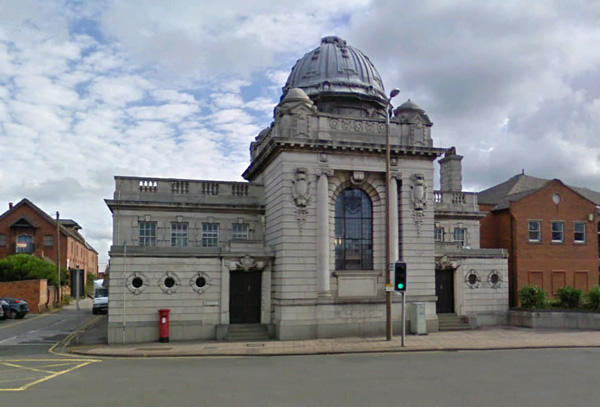
A new magistrates’ court and police station were designed by local architect, Henry Beck and built by local builder, Richard Kershaw. It opened in Horninglow Street in 1910.
Select page to view:
 |
|

A new magistrates’ court and police station were designed by local architect, Henry Beck and built by local builder, Richard Kershaw. It opened in Horninglow Street in 1910.
Select page to view:

Borough magistrates were first empanelled in 1887, meeting weekly in the same place as the petty sessions’ justices but on a different day.
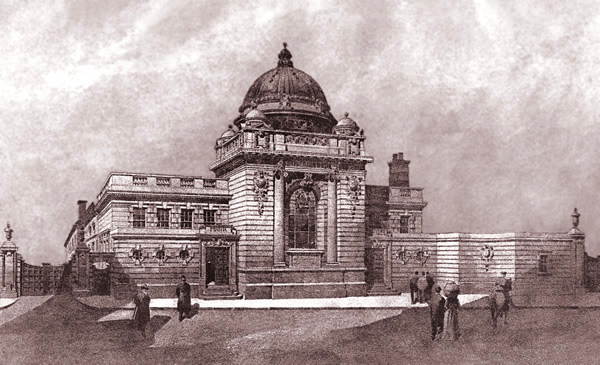
A new magistrates’ court and police station were designed by local architect, Henry Beck. The above architectual drawing, which shows the impressive building, appeared in the 1910 Royal Academy Exhibition. Local builder, Richard Kershaw, was selected to construct the building having completed both the new Fire Station and General Post Office in New Street a few years earlier. Reflecting the confidence of the town at the time, it was constructed from the best quality Portland Stone.
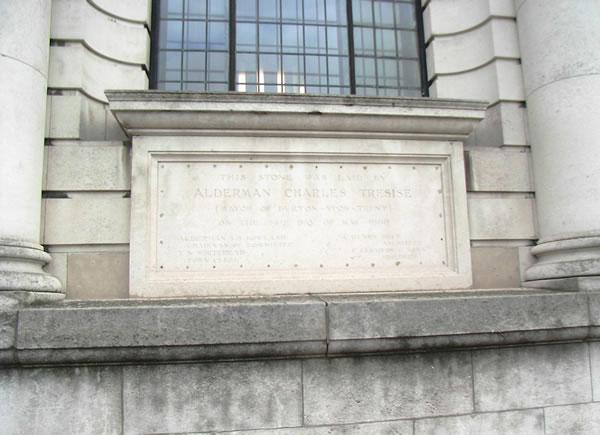
A foundation stone can be found at the front of the building that reads:
THIS STONE WAS LAID BY ALDERMAN CHARLES TRESISE (MAYOR OF BURTON UPON TRENT) ON THE 24TH DAY OF MAY 1909
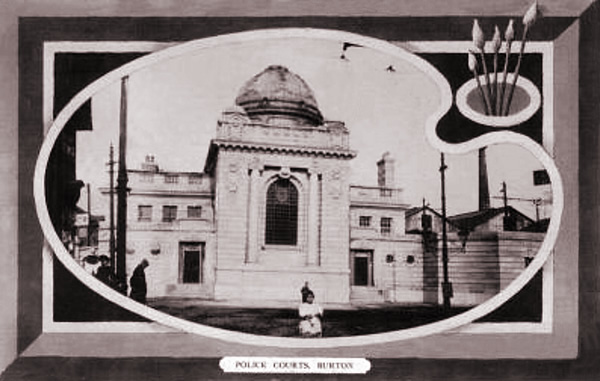
Shortly after the court was opened, this ‘Police Courts, Burton’ artistic ‘pallet style’ postcard was produced. I don’t personally like it at all but it is included here because it provides one of the best available views of the right side of the building with the tramway depot visible at the rear.
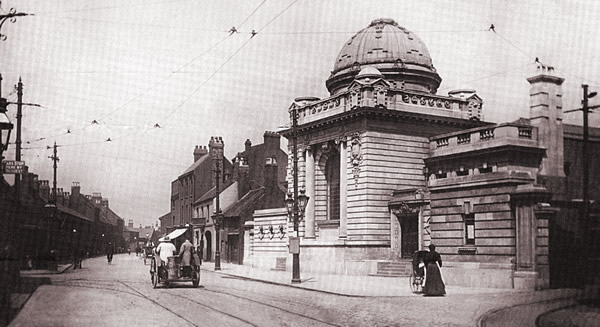
The surrounding area was a little different in this photo around 1911. Tantalizingly, the design of the right hand section has now been changed for some reason.
Originally, there was simply a gate on the left providing access to the police station. A property was eventually demolished to make a road to provide access and parking for the new police station. The new road also provided access to the drill hall.
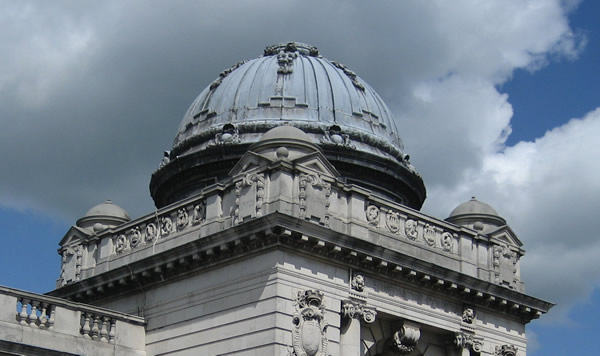
The leaded dome… Burton’s answer to Saint Paul’s Cathedral!
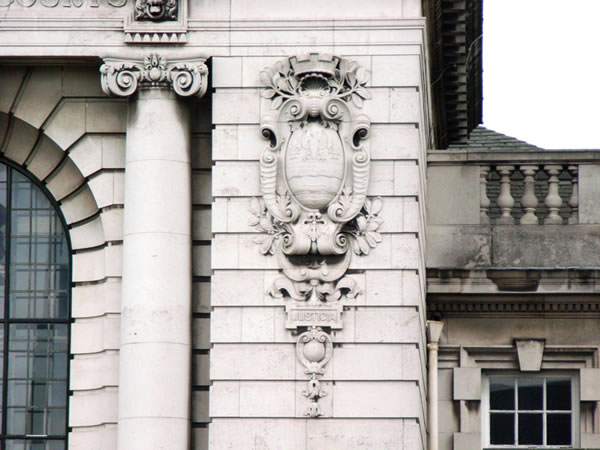
Aside from the expensive materials, top quality stonework was incorporated, again, produced by local craftsmen. It was not a case of having to look afield for expert stoneworkers; Burton was a very up and coming town and it was more the case that expert craftsmen moved to the town knowing that they were likely to find the requirement for high quality work.
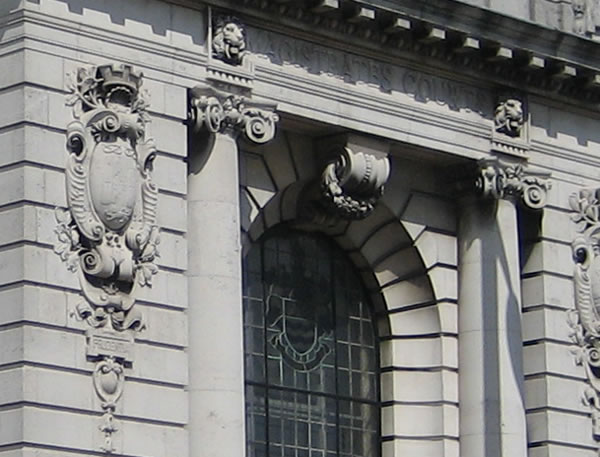
The stained glass window, though not very visible from the outside, bears Burton’s coat-of-arms. It would be nice to get a photo from the inside on a suitably sunny day.
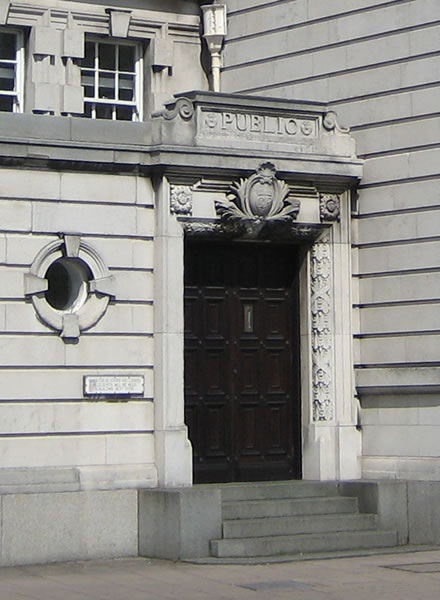
The ‘Public’ door which I dare say many have entered with a degree of trepidation. On the other side of the building is another matching door with stonework informing ‘JUSTICES’.
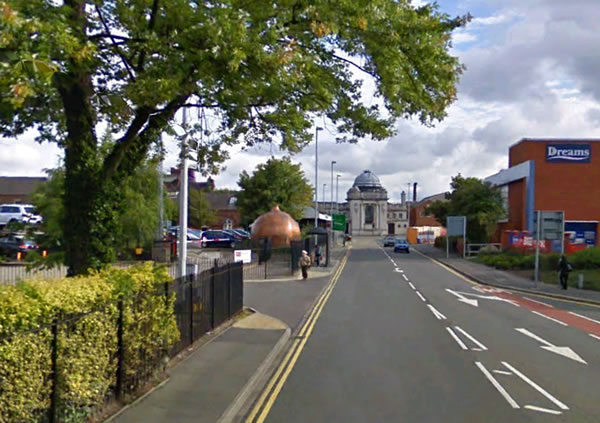
The location was selected to make the most of the expensive building, positioned to provide a strong focal point visible for the whole of Guild Street, which it remains today.
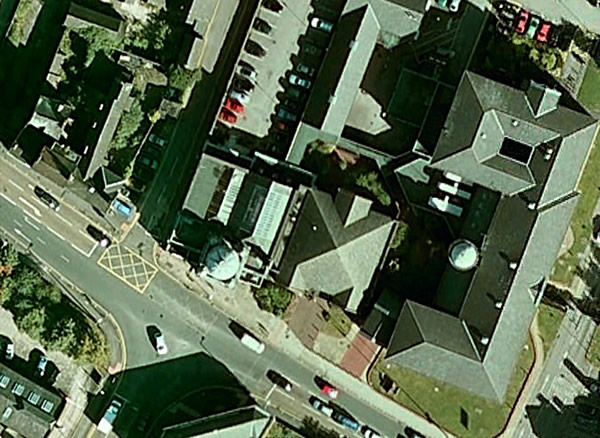
An interesting feature is that once the building was surveyed, it was discovered that it would be impossible for trams to enter and leave the existing depot which was to be its new neighbour. Rather than make expensive alterations to the tramway and depot, it was decided to rotate the whole building by 12 degrees. It is not immediatley obvious from the road but the above aerial view shows it very clearly.
The former Burton Police Station occupied part of what is now the car park at the rear of the old court.
A separate quarter sessions for the county borough was granted by royal charter in 1912. It was abolished under the Courts Act, 1971, but Burton remained the meeting place for petty sessions.
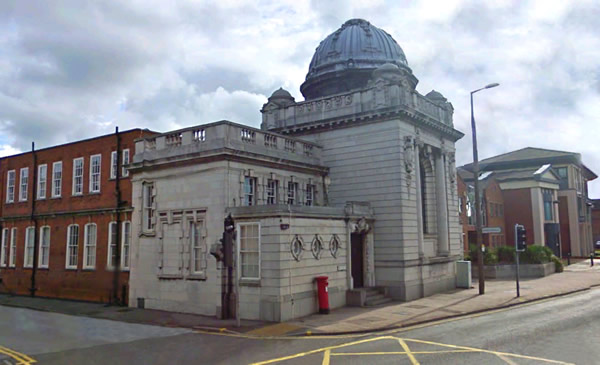
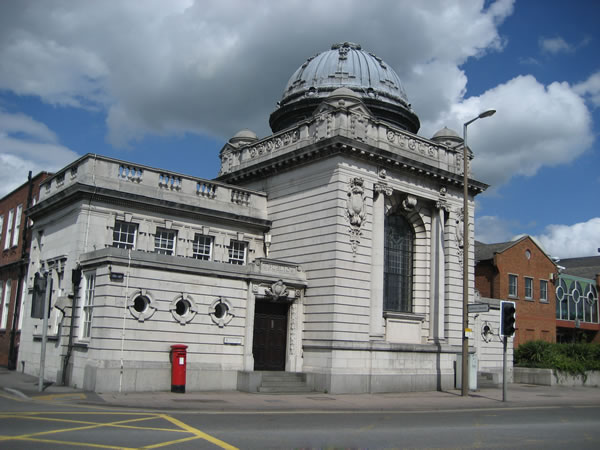

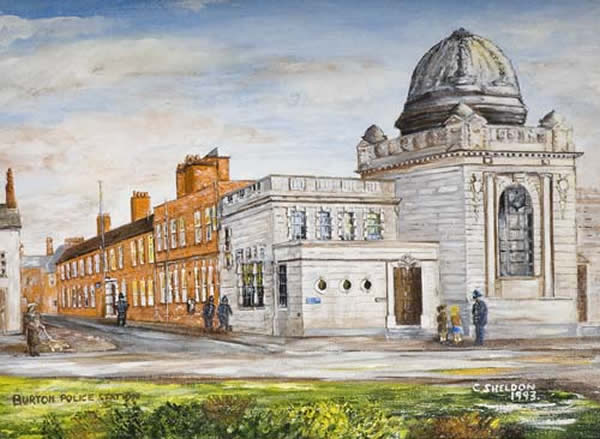
A painting of ‘Burton Magistrates Court and Police Station’ was produced by C. Sheldon in 1993
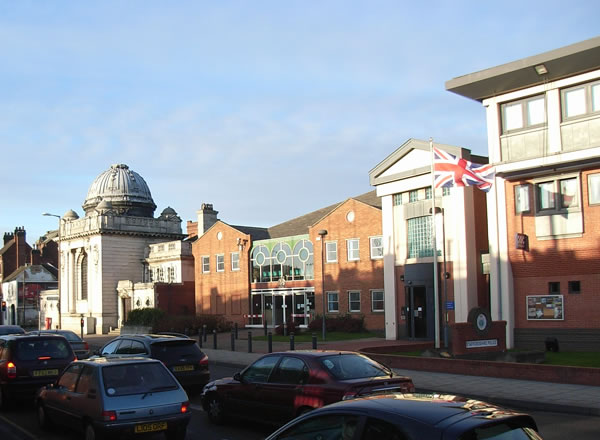
On the site where the tramway depot once stood is the present day complex, opened in 1991, which includes Burton police station, magistrates court office block leaving the once proud building looking a little forlorn, not knowing quite what to do with itself in the world that has overtaken it.
From the inside of the new complex, it is a fairly seamless passage into the old Court 1 which is still used to full capacity for the most serious magistrate cases.
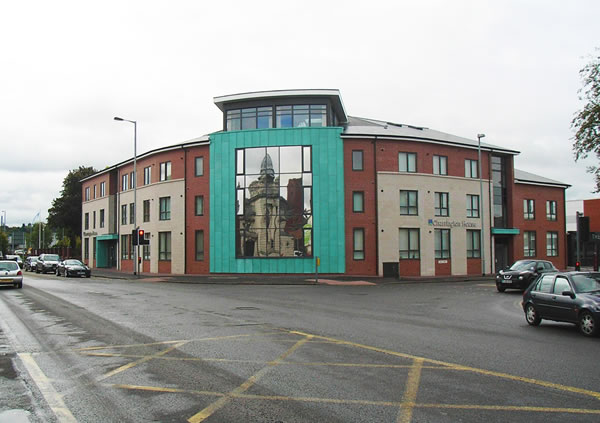
The new ‘Charrington House’ on the corner of Guild Street across the road from the church was build with a large mirrored frontage to provide motorists with an attractive reflection of the old court building.

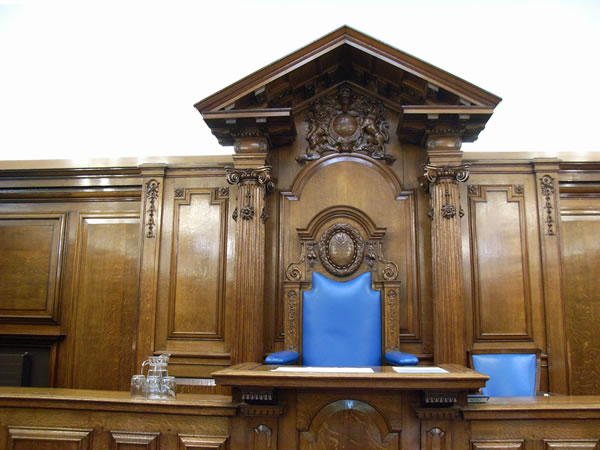 The very impressive Magistrate’s chair with Baroque styling based on the design of the Old Bailey. It is very easy to imagine a red gowned, white wigged High Court judge sitting here ready to announce sentence.
The very impressive Magistrate’s chair with Baroque styling based on the design of the Old Bailey. It is very easy to imagine a red gowned, white wigged High Court judge sitting here ready to announce sentence.
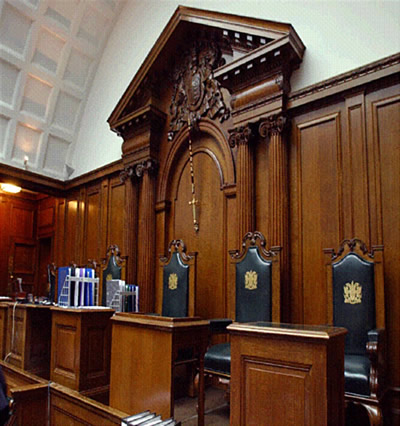 The Old Bailey judge’s chair for comparison.
The Old Bailey judge’s chair for comparison.
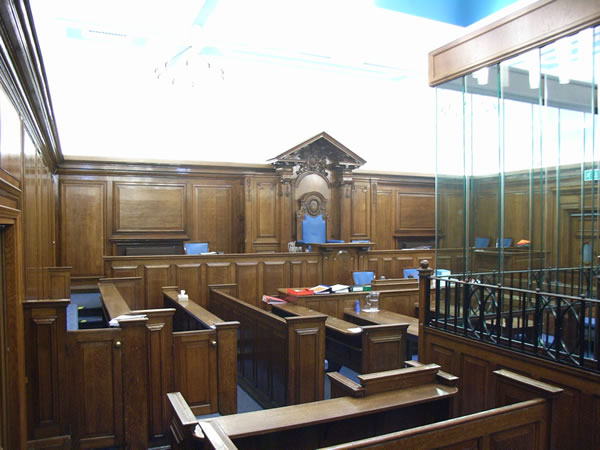 Court 1 is still in very regular use and is little changed, except probably, for the protective glass around the dock.
Court 1 is still in very regular use and is little changed, except probably, for the protective glass around the dock.
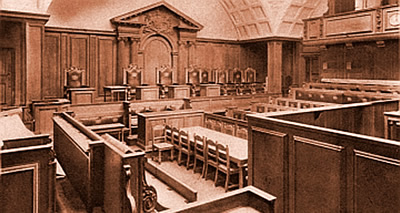 The Old Bailey Courtroom for comparison.
The Old Bailey Courtroom for comparison.
 A view from the Magistrates bench
A view from the Magistrates bench
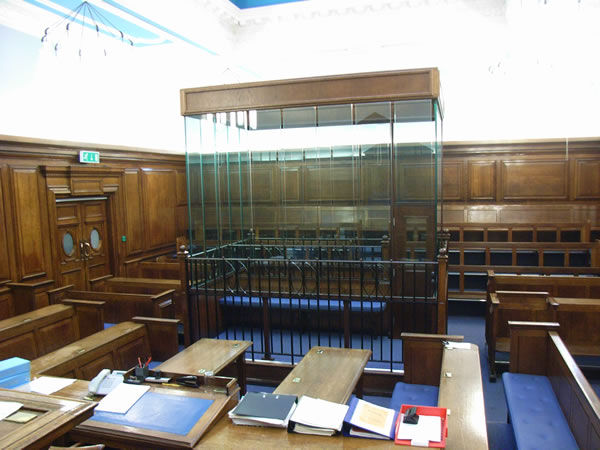 The dock itself looks almost as intimidating as the bench does in the other direction!
The dock itself looks almost as intimidating as the bench does in the other direction!
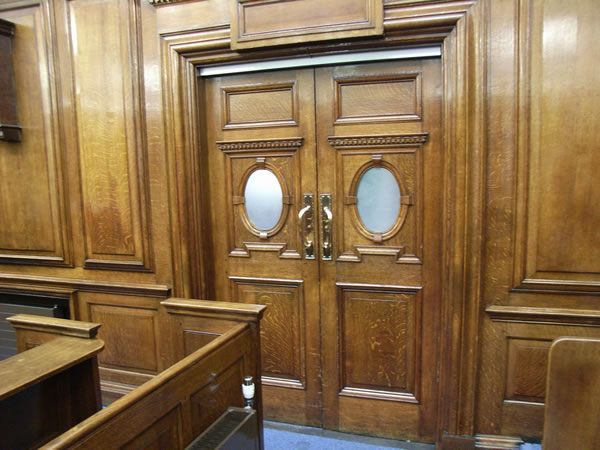 The two pairs of double doors have a wonderful feel about them.
The two pairs of double doors have a wonderful feel about them.
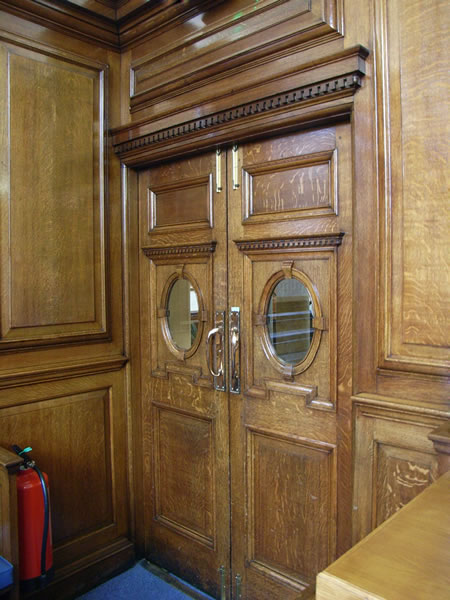
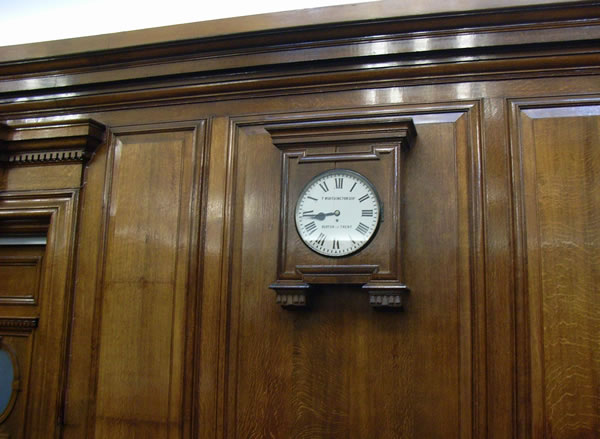 The Court clock sports the name T. Worthington
The Court clock sports the name T. Worthington
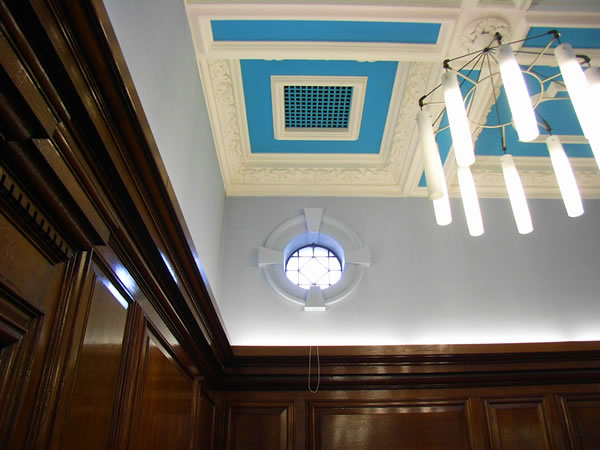 A row of circular windows add to the court’s character
A row of circular windows add to the court’s character
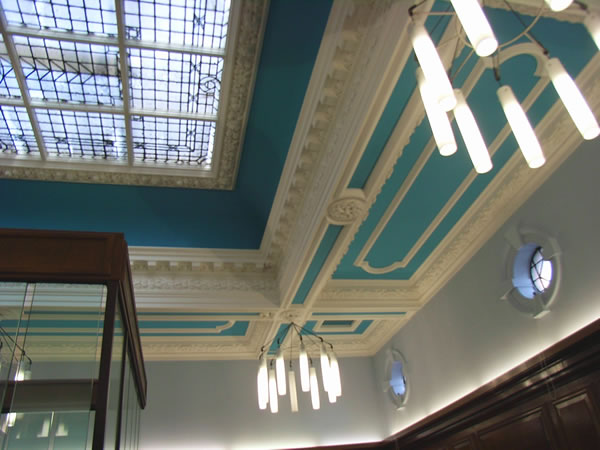 A view of a corner of the ceiling
A view of a corner of the ceiling
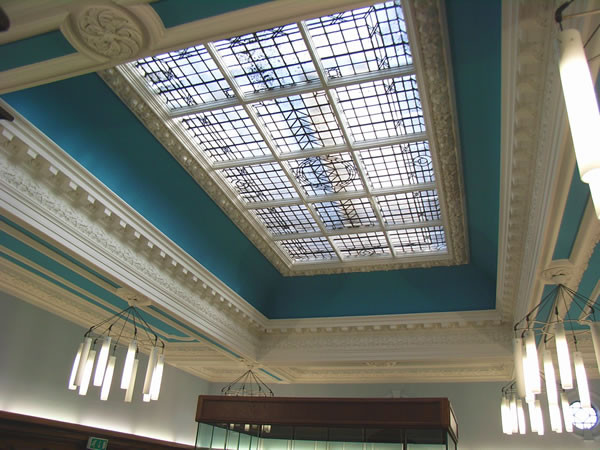 And finally, a view of the impressive skylight
And finally, a view of the impressive skylight
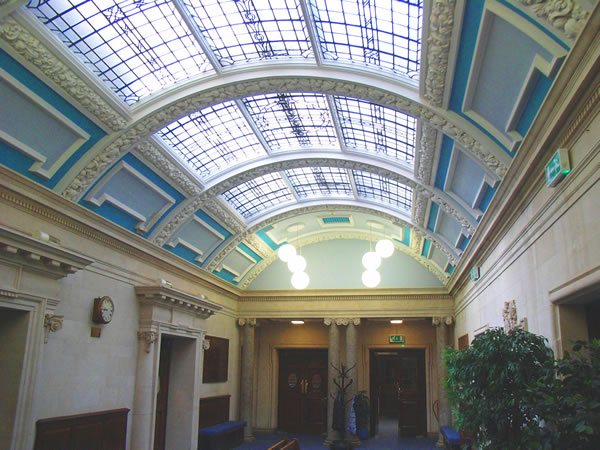 The original waiting room
The original waiting room
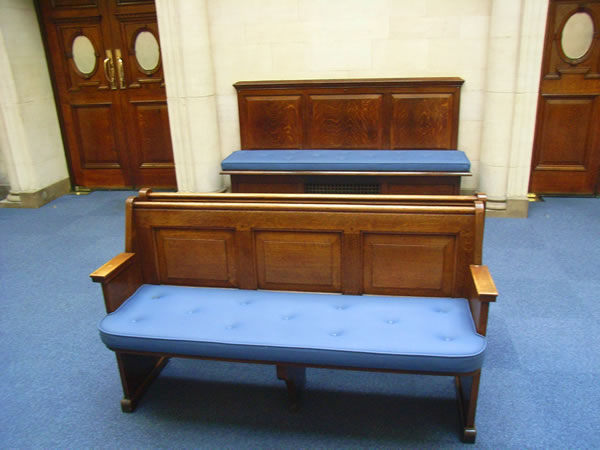 And the original waiting room benches where many an anxious wait would have been experienced
And the original waiting room benches where many an anxious wait would have been experienced
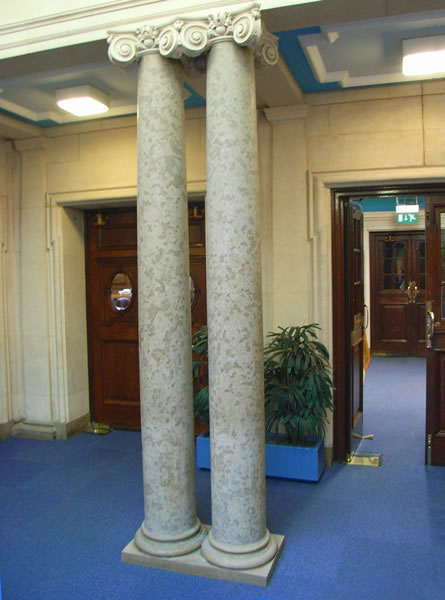 Columns which add to the elegance of the building
Columns which add to the elegance of the building
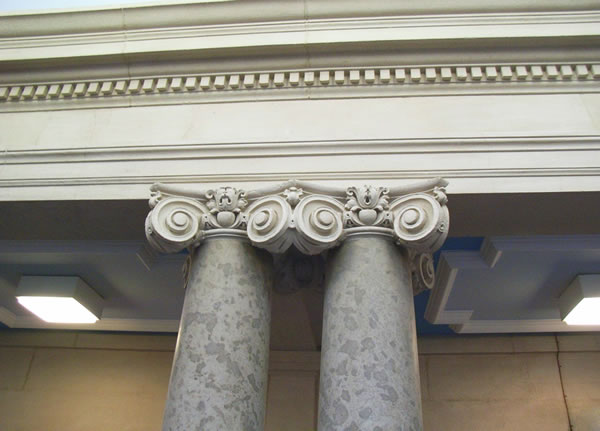 And lovely attention to detail
And lovely attention to detail
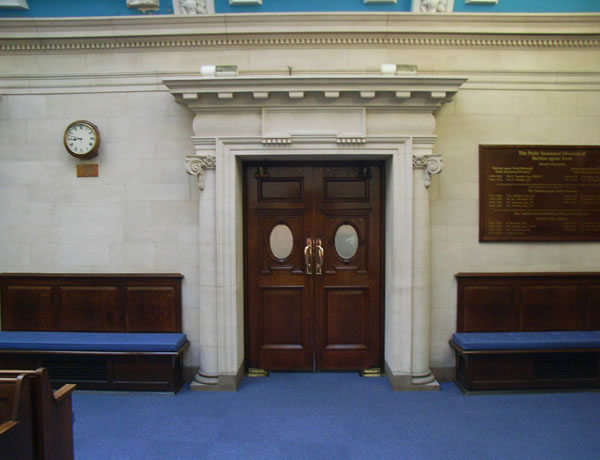 Admiring the doors, it is easy to forget the dread they may have held for some
Admiring the doors, it is easy to forget the dread they may have held for some
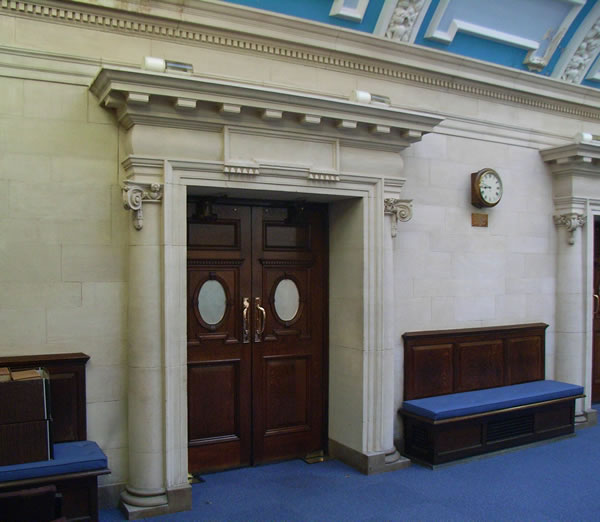
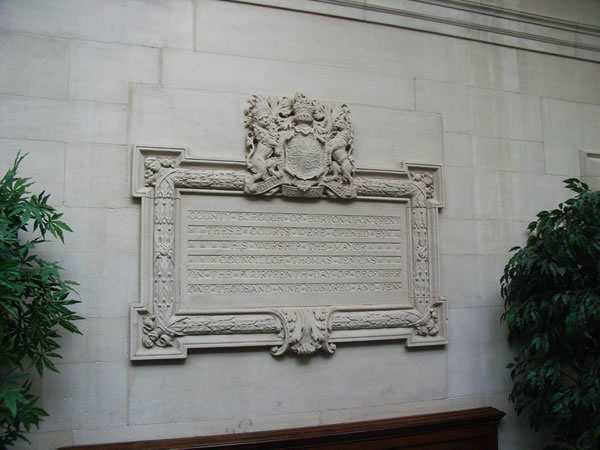 Stonework in the waiting room proudly informs:
Stonework in the waiting room proudly informs: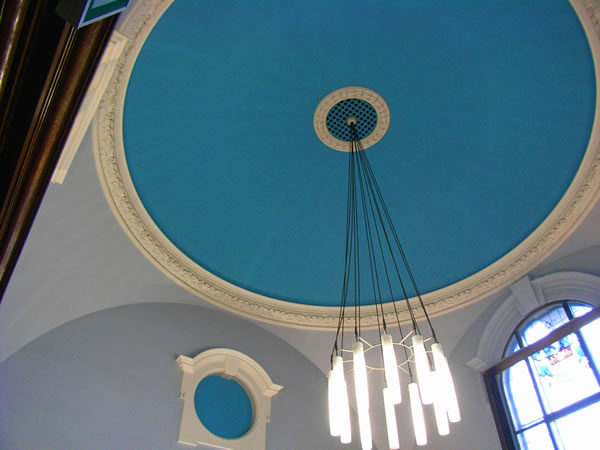 Slightly disappointingly, this is the ceiling directly under the impressive dome. I was rather hoping to be able to see the inside of the dome
Slightly disappointingly, this is the ceiling directly under the impressive dome. I was rather hoping to be able to see the inside of the dome
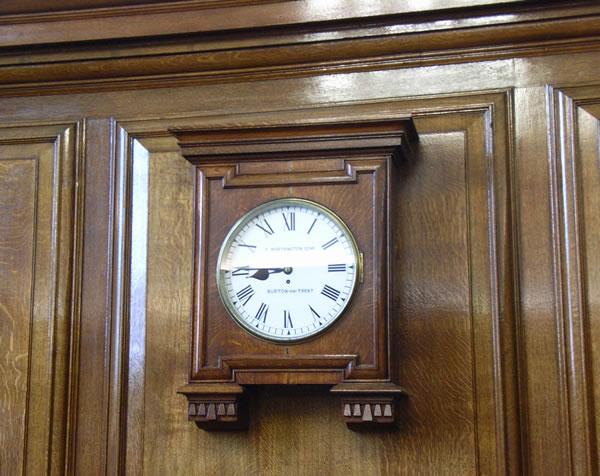 A second clock to match the one in Court 1
A second clock to match the one in Court 1
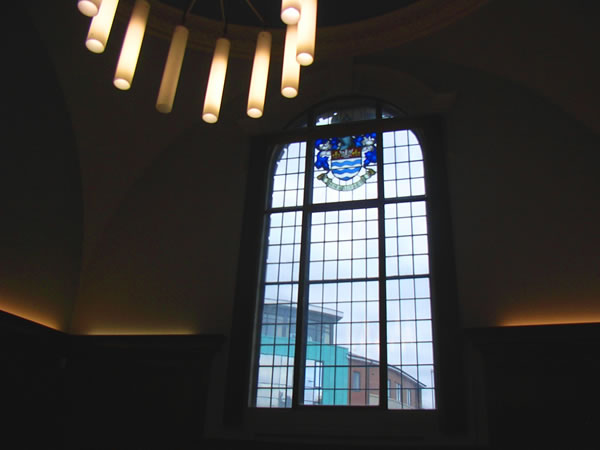 The impressive window that can be seen from the front of the court
The impressive window that can be seen from the front of the court
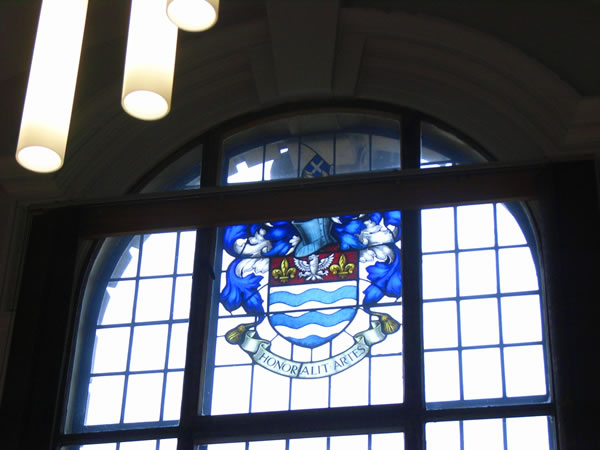 The stained glass window sports the Burton coat of arms and moto
The stained glass window sports the Burton coat of arms and moto
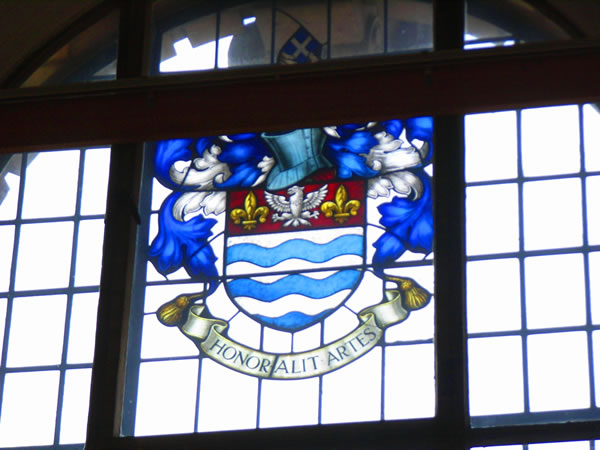
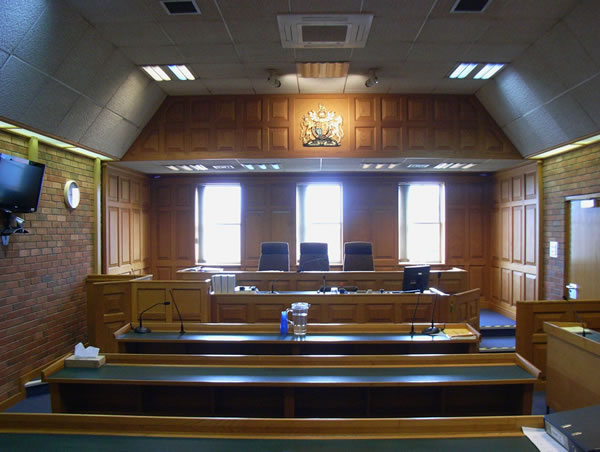 The modern day Court 2 has a much less intimidating feel
The modern day Court 2 has a much less intimidating feel
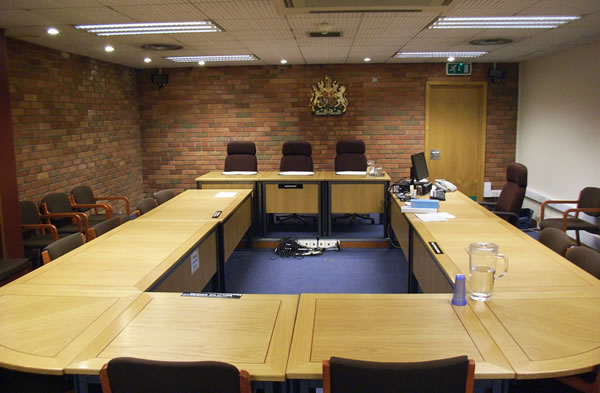 Court 3, used for the least serious and family cases, feels almost like a meeting room
Court 3, used for the least serious and family cases, feels almost like a meeting room
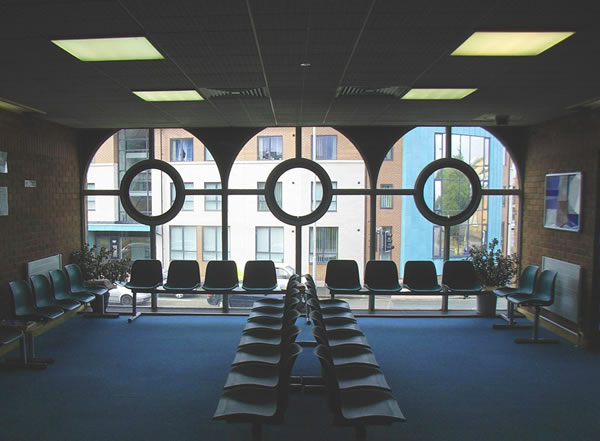 The new waiting room
The new waiting room
In 1873, just two years after the great fire that almost destroyed it, Rolleston Hall was the site of great festivities. Around one hundred and twenty guests celebrated the superbly restored hall at the occasion of the marriage of Sir Tonman Mosely’s son, Oswald.
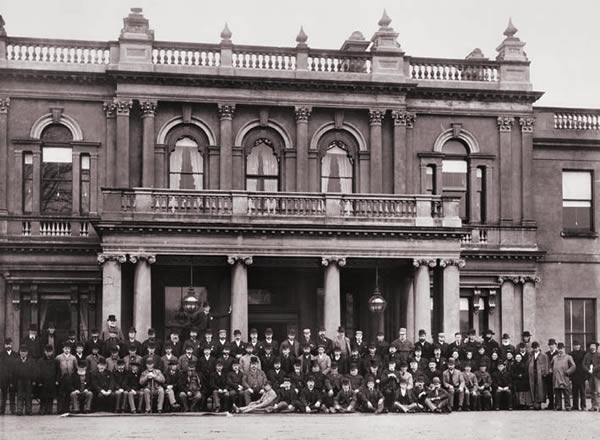
The event was attended and reported by the Derby Mercury and below is a transaction from the detailed report that appeared in an article dated Wednesday, August 20th, 1873.
On Tuesday last the tenantry of Sir Tonman Mosley Bart., were invited to dine at his residence to commemorate the restoration and improvement of the hall; also the marriage of his eldest son, Oswald Mosley Esq. Our readers will undoubtedly remember the serious fire which occurred here almost two years ago. Its owner has now built a noble mansion on the site of the old one, Messrs. Giles and Brookhurst being the architects.
At half past two o’clock on the above day about one hundred and twenty sat down in a commodious marquee which had been beautifully decorated by Mr Buck, head gardener, to a splendid repast. Grace having been said by the Reverend Canon Ram, the dinner commenced in good earnest, under the presidency of their worthy landlord, who was supported on the right by his eldest son, Oswald Mosley Esq., Drs. Belcher and Wolfenden, Messrs Radford, Stretton, M Walker, S Walker, D. Walker, Hodgkinson and Strutt; and on the left by the Rev. Canon Ram and Messrs. Holbrook, Giles, Crump and Pakeman.
The vice chairs were respectively filled by Tonman and Ernald Mosley, Esqs. The bill of fare was a most sumptious one, and we need scarcely add that ample justice was done to it. During the dinner the company were enlivened by Mr Stagg’s efficient quadrille band, which played the following selections in a highly creditable style:
On the cloth being drawn, Sir Tonman proposed the healths of the Queen (Victoria), Prince and Princess of Wales and the Royal Family, which was most enthusiastically received.
The next toast was given by the Reverend Canon Ram, who said;- “I hope you will be somewhat forbearing with me this evening, although I shall endeavour to make all hear. I am quite aware that a great strain upon the voice is requisite for such a numerous assemblage, and especially under a tent.
At the same time, the circumstances under which we are met today would make anyone strive to use every effort for the occasion. I do not for one moment expect I can do justice to the toast of the day, which is entrusted to me… Long life, prosperity and happiness to our host (Loud cheers) But permit me to add I am sure it gives us all very great pleasure to see Sir Tonman in his proper place, and that it is at the head of a large and opulent tenantry. Indeed such a sight as the present is a truly English one, for now can be seen at one view the real backbone of our country, viz., the agriculturists and landlords side by side”.
This was drunk most cordially, the band playing’Musical Honours’ and the ‘Fine Old English Gentleman’.
SIR TONMAN MOSLEY then rose and addressed the company as friends, neighbours and tenants, stating that he was much obliged to his friend the Reverend Canon Ram, for the kind manner in which he had proposed his health. He could scarcely find words to express his feelings. The Canon had spoken of him as a proud landlord, and indeed he was proud as anyone could be of such a respectable and honourable tenancy (Cheers) He trusted he would always be proud of his tenancy, but not proud of himself (Cheers) Such gatherings as the present were a source of great pleasure to him. Landlords and tenants to be successful must pull together. Although he wished to avoid politics he could not let the opportunity slip. There had just been an election, and he was proud to see on the present occasion voters of both sides, for he always wished his tenants to vote according to their consciences (Loud cheers)
He would be very sorry to use undue influence with anyone; and he might safely add that when he met a tenant, it never entered his head as to the political opinions of that tenant (Cheers) At the same time he would add that if a tenant were undecided in his political opinions he considered the landlord was the best tutor for him. He would never canvass, and he trusted that now the Ballot Act was passed the old system of canvassing would become a thing of the past. Again, he thought landlords should not endeavour to influence their neighbours’ tenantry in such matters (Cheers)
With respect to the Game Laws, he had faith to believe that tenants would always protect sufficient game for the sons of their landlord.
Landlords had brought the punishment on themselves by binding their tenants under such severe restrictions and having the produce greatly damaged by the game.(Cheers)
Lastly there was a cry for long leases. He was against treating land as a commercial commodity. In such cases the land would be given to the highest bidder under stringent leases, and do away with all the good feeling that had previously existed. He would conclude by proposing all their healths coupled with the name of Mr Holbrook, their esteemed steward (Cheers.) He asked for the latter gentleman to be excused standing as he was suffering from the effect of an accident.
MR HOLBROOK said that he was very pleased to hear Sir Tonman Mosley explain his views with respect to landlord and tenant so clearly. A good understanding put them on a firm footing for years to come(Cheers) He had the honour to propose the healths of Mr and Mrs Mosley, and congratulate them on the occasion of their marriage, and to take the opportunity of presenting him with the offerings of the tenantry of Rolleston, Needwood and Tutbury.
These had taken the form of a beautiful timepiece, silver tankard, and silver tea and coffee service. He concluded by asking the company to drink long live and happineass to Mr. and Mrs. Mosley.
This was immediately followed with musical honours.
OSWALD MOSLEY, Esq. was received with loud cheers. He thanked all of them for the presents they had so kindly given Mrs. Mosley and himself on the event of their marriage. He was sorry that his wife was unable, through illness, to be present that day. His father, however, had given him a cordial invitation to Rolleston Hall, which he should from time to time accept, especially in the hunting season (Cheers)
He was sorry that last year he was not so frequently in the field, but the fact was hunting did not agree with love-making (Cheers) He added that he was not an orator, but they would accept the best thanks of himself and wife for the kind manner in which their health had been proposed and received.(Loud cheers)
The next toast was given by the CHAIRMAN, who said, “Gentlemen, it falls upon my lot to propose the Bishop and Clergy, coupled with the Rev. Canon Ram, our worthy Rector. He was not going too far when he said, that the Canon had, by his assiduous work made himself many friends in Rolleston and neighbourhood (Cheers) He had learned from many sources of the efficacy of the rector’s service among the tenantry, who was in that position that he could serve them both spiritually and temporally. He had known him ever since he could remember, hence he claimed him as one of his oldest friends”.
The above toast was then drunk with cheers and musical honours.
The Rev. CANON RAM responded by stating that he was grateful to Sir Tonman for the kind manner in which he had proposed his health. He went on to say that the baronet had done him justice when he said that ‘best intentions were not wanting in his work’ (Cheers) He referred to his old associations with Rolleston, how that some years before Sir Tonman could remember, he spent many happy hours fishing in Rolleston brook with the late squire, the host’s brother. It was owing to the kindness of Sir Oswald that he now held the position of Rector of Rolleston. Such a position naturally brought pleasant and unpleasant remembrances. During the five years he had been amongst them as their pastor, he trusted he had served them faithfully, and he hoped all good feelings and blessings would continue to crown the hall, church, and yes, and every house in the parish, as proof of God’s mercies to them.(Hear hear). There were persons now- a -day who tried to separate classes, but he considered such meetings as the present one went far to put down their evil attempts, He must, however, conclude, but when once on his feet and among his friends, he was like the Irishman who was asked the secret of being such a good speaker, I put my heart to the tip of my tongue, and then I can’t help it. He must, however, say one word more, and that was something which was very pleasing to them, viz., to propose the health of Lady Mosley (Loud cheers). He knew it would be well received. The tenantry had only to look at her, and then listen, and they might rest assured that her influence with Sir Tonman was always used when required on their behalf. Indeed all of them would be very poor creatures without their wives, daughters and sisters. He then, amidst loud cheers, proposed ‘The health and happiness of the Lady Mosley, as wife and consort of Sir Tonman Mosley, Bart’. (Loud cheers)
After musical honours had been accorded, Sir Tonman rose, and in a short humorous address, thanked them on behalf of his lady, whom he had on this occasion deserted for the first time in her life; she had declined to thank his friends for their good wishes. He trusted she had not made up her mind to desert him altogether (Renewed cheers) he quite agreed with the Canon as to the value of wives, and he trusted that all his friends present who had not entered the matrimonial state would immediately fix their attention on a suitable lady, and get married at once. (Cheers)
Dr. BELCHER then rose, and in a pithy speech proposed ‘The health of Tonman and Ernald Mosley Esqrs,’ the younger sons of their worthy host. He trusted the tenancy would fill their glasses and do their duty by the toast. (cheers and musical honours)
TONMAN MOSLEY Esq., replied as follows; The Reverend Canon Ram has made a pointed remark in his speech which has given me a new and very humble opinion of myself. He said “All men without wives were poor creatures, and still more so if they had no sisters or daughters” Now I have no wife, no sister no daughter, therefore pray pity me, for I must be a very poor creature indeed (Laughter and cheers.)
Again I can assure you I tremble in my shoes, for my father in his speech says thast the sooner men get wives the better for them; and I of course conclude from that he must have someone in his eye for me! I humbly offer you my sincere thanks for myself and my younger brother, and I trust you have all been happy and will spend the remainder of the day in perfect enjoyment. In a short time I hope to be called to the bar, and I ask you after I have so done to get into as many lawsuits as you possibly can and put a corresponding number of guineas into my pocket (Cheers.) One more point;-My ambition may induce me in course of time to become a candidate for your votes as a member of parliament. In that case I have no doubt all of you will give me your support, and place me at the head of the poll. I feel most deeply the honour which has conferred upon me is being entrusted to a toast which ought never to be left out, and is always received with great eclat. My toast, gentlemen is one you will all respond to most heartily, viz.,”The Ladies”(Cheers.) Gentlemen, they are our better halves, but dear me I must beg your pardon, as I ought to have said your better halves. Still I beg to propose the health of your wives, your daughters and your sisters. At the same time I think you will agree with me that an able orator by late reputation, is the fittest person to answer for those whose absence is our loss and whose health we shall drink most heartily (Cheers.) I therefore call upon Mr. Samuel Walker, who is considered an orator in this neighbourhood, to respond.
MR S. WALKER immediately rose and said he wished to contradict Mr. Tonman Mosley upon one point in his speech, viz., that of being an orator; and he thought the compliment of returning thanks might have been placed in abler hands, as he was suffering from overwork, the result of canvassing in company with Messrs. Higgot and Hopkins, when they had had many strange questions put to them relating to the gun tax, tenants rights, school boards, ladies as voters &c. But he must revert to the toast viz., “The Ladies” He had tried housekeeping and bachelorship for five years, but could endure it no longer, so took unto himself his better half, and had no hesitation in stating that it was the best day’s work of his life. He now had his slippers placed for him every evening, and his bed warmed when required, and many things which a bachelor could not expect, and did not deserve. He hoped that Mr Tonman would soon follow his example and so become a useful member of society.
SIR TONMAN next proposed the healths of the master workmen who had been employed at the hall during it’s restoration, coupled with the name of MR GILES, who responded as follows- Gentlemen- this is indeed a very happy gathering through the generosity of Sir Tonman. He has spared no trouble or pains to secure a pleasant afternoon for us, and I can safely add that during the restoration of the hall, it has been his constant endeavour to make all who were employed on the works very comfortable. He (Mr Giles) had never undertaken a work that had given him so much pleasure, and it mainly arose from the frankness and generosity of their noble employer. He begged to offer the best thanks of his co-workers for the manner in which their healths had been proposed and received, and he trusted Sir Tonman and her Ladyship would live for many many years to enjoy it’s beauties, conveniences and pleasures (Loud cheers.)
Music and songs now became the order of the evening, among which we noticed ” The Old English Gentleman” by Messrs. M and S Walker ; Turn of the tide” by Mr. Pakeman; “John Barleycorn” by Mr. G Hanson: “Paddy’s courtship” or “The Whistling thief by Mr. Strutt; Men of Merry England”, by Mr. Hodgkinson; and “Nought else to do” by Mr.Greatorex. The latter was highly amusing and well executed, and caused great laughter.
The company broke up about half past seven o’clock after singing the National Anthem.
We need scarcely add that the afternoon was spent in a most enjoyable manner and nothing was wanting to add to their happiness that money would procure.
The oldest parishioner of Rolleston who was present said that he “had never seen such doings in all his life.” We trust such gatherings may become more frequent, and may we add annual ones. Sir Thomas kindly threw his grounds and gardens open, and was lustily cheered by his tenantry from the marquee to the mansion.
The following day, the workmen, numbering 165, were invited to dinner, which was equally sumptuous to that of the previous day The “Roast Beef of Old England” was punished by a class of men who well know how to do their duty with a knife and fork , accompanied with copious draughts of nut-brown ale , and fine selections of music which on such occasions improve the appetite and assists digestion. No comment is needed as to the justice they did to the good things.
After the cloth was drawn,
SIR TONMAN briefly proposed the healths of the Queen and Royal Family.
THE REVEREND CANON RAM, after a telling speech, proposed the healths of Sit Tonman Mosley, Bart., the Lady Mosley, and |Mr. And Mrs. Mosley, to which the worthy baronet responded, followed by Mr. Mosley and Mr. Tonman Mosley.
On the retirement of Sir Tonman Mosley from the chair, speeches and songs followed in rapid succession. A little momentary unpleasantness was occasioned at times by two or three amateurs endeavouring to give their fellow workmen a specimen of their musical prowess simultaneously . Of course this created much mirth, and the cases had to be referred to the chair, which was now ably filled by Tonman Mosley Esq.
MR BRATT made a speech which will not be easily forgotten by those who had the advantage of listening to his oratory.
The proceedings came to a close by the chairman expressing his best thanks to them for their excellent conduct during the afternoon, and trusted they had all thoroughly enjoyed themselves, leading them to believe this was only the first of similar entertainments. The marquee was momentarily filled with loud cheers and good wishes for their noble master.
On Thursday a large company of visitors were invited to an entertainment, and to witness the sports of the Rolleston, Tutbury and Anslow schools whom the liberality of Sir Tonman Mosley would not permit to be overlooked. The following were amongst the number; Sir Henry Every, The Masters Every, Rev. Rowland and Mrs Mosley and family, the Rev. Canon, Lady Jane and the Misses Ram, Mrs Stone, Mrs.Fox, Miss Isobel Mosley, Miss Penelope Mosley, the Misses Bott (3) Miss Wearg, , Mr/ and Mrs. Willoughby Wood,, Mr. and Mrs Wm. Bott, Mr and Mrs Rumboldt, Mr. and Mrs. N Curzon, and the Masters Ewart.
Also the annexed were among the number as resident at the Hall for the week; Mr. Mosley of Beaumaris, Anglesea, Miss Foster, Miss Halliwell, Miss Rigby, mr & Mrs Campbell, Mr. Lucas Broadhurst, Mr Lindesay Young, &etc.
The Rolleston and Anslow children arrived first, and were conducted through the gardens. At two o’clock the Tutbury children, under the control of the Rev. H. Clunn, Miss Bray and Mr. Parrick, started from their respective schools, the route being by High Street and Burton Street. The youths belonging to the Endowed School halted at the residence of Miss Mosley (Sir Tonman’s sister) and sang “The Red, White and Blue” and “Musical Honours” in a highly creditable style, under the able guidance of their respected master, Mr. Parrick. Many of the inhabitants turned out to listen to the songs and witness the procession of the children who were bent on an afternoon’s pleasure.
Miss Mosley very kindly thanked the master, teachers, and pupils for their courtesy. The girls, who waited in the Burton-street during this show, now proceeded in excellent order towards Rolleston, amidst cheers of the crowd. On approaching the Hall Gardens, it was understood by the excessive “Hurrahs” that it was a gala afternoon at Rolleston. Mr. Buck met them at the reservoir, and led them through most refreshing shady walks through in the garden, and finally to the front of the Hall, explaining, as they proceeded, the various orchard and hot-houses, with their uses. He earned and received many hearty thanks by his thorough and genuine kindness from both teachers and scholars. In about ten minutes they took their places on the croquet ground for singing. The company quickly congregated around the little band to hear the following songs which were executed in such excellent tune and time that praises were awarded in all directions:
Musical Honours followed with the words:
Sir Tonman is our faithful friend,
And that we all do know,
He always helps us cheerfully,
Which nobody can deny,
The Lady Mosley we do thank,
For all her kindnesses,
We wish them every happiness,
And so say all of us.
SIR TONMAN MOSLEY expressed his best thanks to Mr. Parrick and gave orders for the pupils to be conducted to the Park , in which the following games were prepared;- Cricket, Football, Bag racing, pole climbing, wheelbarrow races etc., Prizes were awarded by various gentlemen who witnessed the sports. Mr. Tonman Mosley superintended the cricketing, while Mr. Mosley undertook the racing and Mr. Ernald the football.
At five o’clock the bell rang for tea, to which they immediately responded. Mr. White, butler, was exceedingly kind throughout the evening, and most anxious to do everything possible for the enjoyment and comfort of the children. Many thanks are due to him for his attention. Grace having been sung, they set to work in earnest to clear the tables of the tempting eatable commodities, consisting of buns, ginger bread, plum cake, preserves, grapes, currants, gooseberries &c. Half an hour sufficed to see the end of this department.
After the Grace had been sung, Sir Tonman entered the marquee, accompanied by the Lady Mosley and The Rev. Canon Ram.
The Reverend Canon, in speaking to the children assembled asked them whom they had to thank for their tea. Their answer was “God.” The rev. gentleman said it was a very good answer, and he was glad to hear them award the praise to God. He then asked who they were next indebted to. Their answer was “Sir Tonman.” He gave them good advice, in which he cautioned them against bad company, and concluded by asking for three cheers for Sir Tonman and Lady Mosley, which was given in a thoroughly English style. Mr Tonman, in a short address, informed the children of the very great pleasure it afforded Lady Mosley and himself to meet them in such pleasing circumstances. He had invited them to tea and games to commemorate the restoration and improvements to his residence, Rolleston Hall. He had trusted that they would all be good children, not only for that afternoon, but for many future ones. He was glad to see such a goodly number present but was sorry to be obliged to hear that some were absent, not being allowed to come through irregular attendance at school. He went on to show that as a rule the parents were the cause of the irregularity, and it was greatly deplored that in these enlightened times they did not take a far greater interest in the future welfare of their children. A child now-a-days without education was no-where in the world. Again he was proud to refer to the fact that in each of the schools present instructions in the Holy Bible formed part of the daily routine. He remembered well the words of his father to the effect that school instruction was quite valueless without it was based on God’s word and he should use his influence to maintain those principles. “Shut out the Bible from the school and you will undermine it’s true utility.” He thanked the teachers for the excellent discipline which their children exhibited, and concluded by trusting that this meeting was only a fore runner of many similar ones. (Loud cheers.)
The children then sang several songs and dispersed to enjoy the several amusements prepared for them. At a later hour dancing commenced in good earnest, and was kept up till dusk. Mrs. Smythe, the Anslow schoolmistress,collected her little band the first, and they were well attended by the gentry, previous to their departure, with nuts and biscuits. Later on the Tutbury schools were arranged in front of Mr. Stagg’s quadrille band, and after musical honours for their host and hostess, sang the National Anthem. Mr. Parrick addressed the children, and thanked Sir Tonman and Lady Mosley for their great kindness, and trusted Mr. And Mrs. Mosley would follow in their worthy parents’ footsteps especially with regard to the aid they most generously bestowed on the schools . He concluded by calling for cheers for the above. On arriving at Tutbury, they proceeded to the residence of Miss Mosley and sang a song or two, after which the order was given to dismiss. The Rolleston children, under their efficient master and mistress Mr Eley and Miss Ellis, were dispersed later on in the evening. Such a day’s enjoyment has seldom, if ever, been accorded to these schools.
The following evening a ball was given. Through the liberality of Sir Tonman all the servants of the neighbourhood (200) were invited to the hall. Carriages arrived in rapid succession at eight o’clock, and the respective occupants were escorted to the cloak room by Mr. White. Tea and coffee were set out in the smoke room, and all new arrivals were invited to refresh themselves preparatory to the dance. At nine o’clock the strains of Mr. Stagg’s efficient quadrille band were heard, and a general movement was made towards the saloon, which was in itself worthy of a visit. It was illuninated with two sun lights, and as the company arrived in their various coloured costumes the effect was exceedingly pretty. This room was most tastefully decorated with flowers, evergreens. flags and shields under the able superintendence of Mr. Buck.
The motto “Mos Legem Regit” came out most prominently on the North Wall. The floor deserves a word of notice, being of the very best oak, polished, all of which has been grown on the Rolleston Estate. The stewards of the evening were Tonman Mosley, Esq., and Mr. White, who were quite at home with their duties.
At a quarter past nine o’clock the ball was opened by Mr. Kirk and the Lady Mosley, followed by Tonman Mosley, Esq., and Mrs. Stevens. About 150 joined in this, it being the well known country dance “Triumph”. Mr Cornish’s perfect mastership of the cornet deserves special mention.
The next was a Polka in which Mr. Joseoh Barton had the honour of dancing with her Ladyship. The following was the programme which was well carried out, and a Scotch Reel or two were added by special request :-
At one o’clock the company sat down to an excellent supper, which was set out in the marquee. The tables were laden with good things, and bore ample proof that the week’s festivities had not drained the vineries. Grace having been sung, about half an hour was occupied with toasts.
Mr. Abby proposed the healths of Sir Tonman, the Lady Mosley, and mr. And Mrs, mosley, which was responded to by Tonman Mosley Esq,.who asked for a little fore bearance as it was the fourth speech he had been credited with in the past few days .
He said that nothing would have given his father greater pleasure than to have been present on this occasion, but lameness prevented him. He hoped they would all thoroughly enjoy themselves and dance to their hearts content, He concluded by proposing the health of all his father’s servants, who had been most severely taxed with over work during the week, coupled with the name of his esteemed friend, Mr. White,
This was drunk most cordially with musical honours, led by Mr. Parrick,
MR. WHITE acknowledged the compliment in an able manner.
After Mr. Stagg had said a few words on behalf of the visitors, the company, like giants refreshed, returned to the charge, and the small hours of the morning smiled on the throng. Slowly and reluctantly the company broke up to return to their homes by the morning light, and to regret the fleeting haste of our old enemy, Time.
On Saturday about 100 of the old parishioners were invited to tea on the lawn. Various amusements were engaged in and the garden and grounds thrown open.
Thus ended a weeks festivities, the like of which has never been seen by the present generation of Rolleston.
We conclude our report by by sincerely wishing that the worthy owner and his lady will live long to enjoy each other’s friendship in their princely mansion.

In 1871, a serious fire swept through Rolleston Hall, which was undergoing major renovation at the time. It caused significant damage and at one point, even looked as though the entire hall could be completely lost.
The incident was widely reported. Below is a transcription of the article that appeared in the Derby Mercury on 25th October, 1871:
A disastrous fire broke out early on Thursday morning, at Rolleston Hall, the seat of the Mosley family, which for a time, threatened to demolish the whole of the building. The hall, has since the death of the late Sir Oswald Mosley, Bart, been undergoing considerable renovation, and a new wing was being added, previously to the present Baronet, Sir Tonman Mosley, entering upon it. A considerable number of workmen were therefore employed at the hall, but at the time the fire broke out it was only tenanted by two domestics, the butler and his wife. How the fire originated is not definitely known, and it seems likely to remain a mystery, the over-heating of the rooms, caused through airing, preparatory to their being tenanted being generally assigned as the cause.
The Hall is situated about four miles from Burton and about a quarter of a mile from the village of Rolleston. It is an old baronial residence, picturesquely situated in the valley of the Dove, and surrounded by a number of fine old trees. It has an extensive frontage to the south and west, and this front comprises a suite of elegantly-furnished rooms, hung with a large number of fine old paintings, many of which are of great value. The late Sir Oswald’s extensive library was also in this portion of the house, and here might be found an immense number of very rare and choice works, both scientifical, historical, biographical, and religious, besides numerous miscellaneous volumes.
The fire was first discovered about five o’clock, and a messenger was immediately dispatched to Burton for assistance. The two town engines, and Messrs. Bass and Co.’s and Messrs. Allsopp and Sons’ engines were quickly en route for the scene of the conflagration, where hundreds of willing hands from Rolleston and the neighbouring villages were busily engaged in trying to stop the progress of the flames. Fortunately, there was an excellent supply of water at hand from a neighbouring fishpond. After a few hours’ hard work the progress of the flames was arrested, and the fire to a certain extent got under. The furniture, paintings, and books were, with great effort, saved, with but little injury; but the butler’s pantry suffered considerably, and a quantity of plate was melted. The whole of that part of the building where the fire originated was completely guttered, owing to the walls being composed partly of timber; and so destructive were the flames, that the roof fell in with a terrible crash. The new wing which is being erected was fortunately saved, as well as the back part of the house. Supt. Oswell, with a body of police from Burton, were soon on the spot, and rendered great assistance in organising the staff of workers. We hear that the whole of the injured property is covered by insurance.
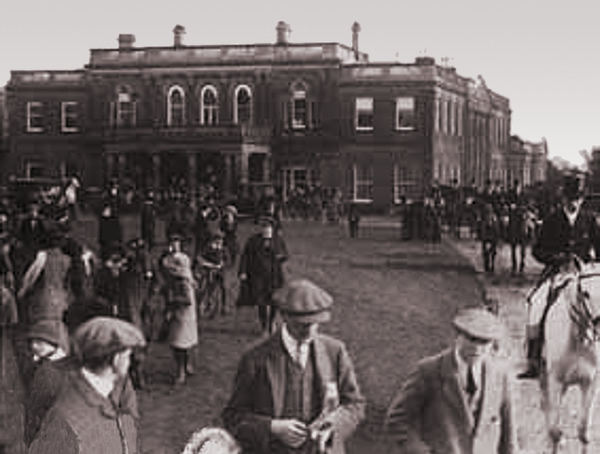
The above photo was taken the year after the great fire with the Mosely family very relieved to be able to demonstrate that the fully repaired hall remained a central part of the local community.

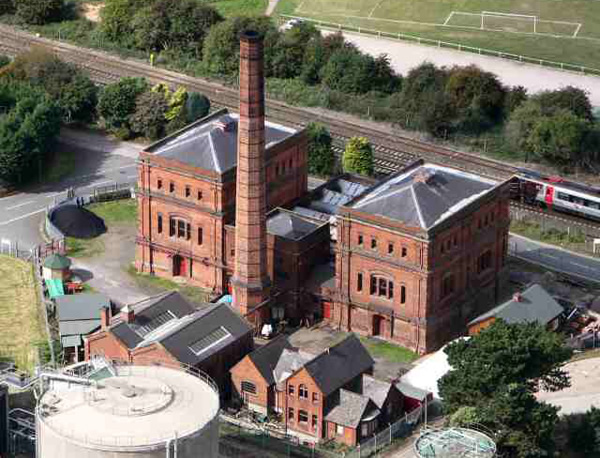
Claymills Pumping Station is an excellent example of Victorian engineering and has buildings dating back to 1885. It was important in the development of Burton upon Trent during the Victorian age, bringing much needed improvements to local sewerage handling.
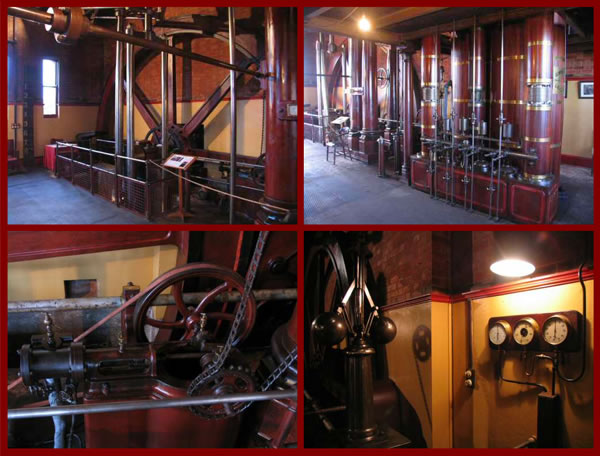
It has been preserved as a museum offering a varied programme of talks, guided tours and hands on learning, and is described by English Heritage as ‘the most complete site of its kind in the UK’.
It has a website of its own so, rather than replicate, I provide a simple link:
Select page to view:

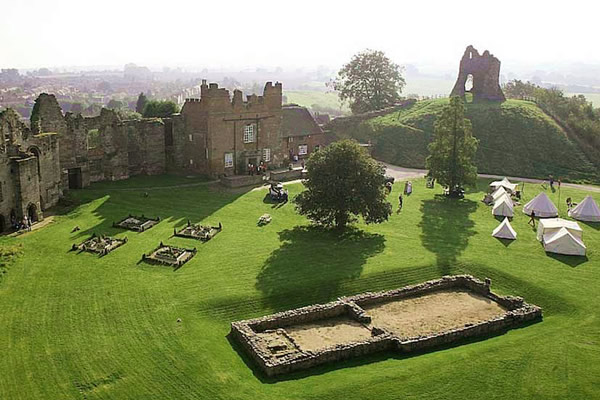
Tutbury Castle is one of Burton area’s most historic features. It is already covered on another excellent local history website which pretty much duplicates what I would feature here, I will therefore, simply provide a link.
Select page to view:

In the early 1800s, a number of publishers produced county directories, a sort of forerunner of the Yellow Pages, which have become a valuable source of historic information. Among the most popular were Bradshaw & Parsons Directory of Staffordshire, Bagshaw’s Derbyshire Directory and White’s Directory of Derbyshire.
Below is an extract from the 1857 Whites’s Directory of Derbyshire. Burton upon Trent, at this time lying in both Staffordshire and Derbyshire with the county line being formed by the river Trent, appeared in the Derbyshire edition. It was organised by Town and each was described in some detail so providing an invaluable record. The Burton upon Trent entry is fully transcribed below, surrounding townships were in separate sections, I have included Winshill as an example:
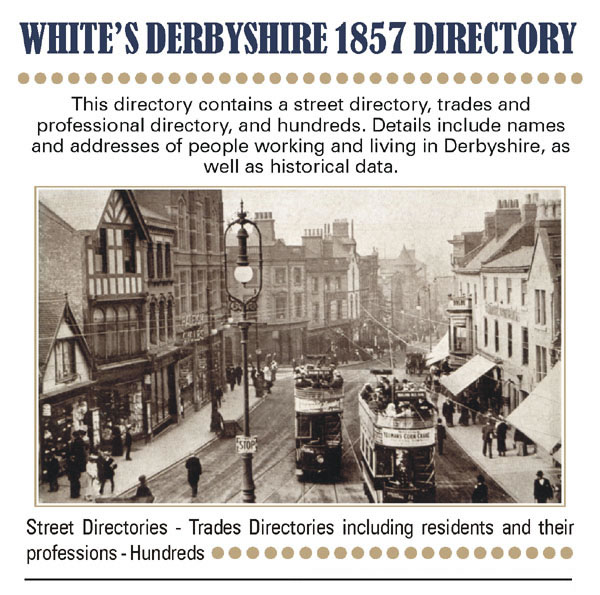
BURTON-UPON-TRENT is an extensive parish, principally in the Offlow Hundred, Staffordshire, and partly in Repton and Gresley Hundred, Derbyshire. The entire parish comprises 7 townships, viz. : Burton-upon-Trent, Burton Extra, Branstone, Horninglow, and Stretton, in Staffordshire, with Winshill, and part of Stapenhill, which are in Derbyshire, with about 10,000 acres of land, and in 1851 had 2,250 houses, and 12,373 inhabitants, of whom 6,189 were males, and 6,184 females. The manor of Burton-upon-Trent, with several hamlets, was granted in the 37th Henry VIII. to an ancestor of the present Marquis of Anglesey, who is lord of the manor, principal owner of the soil, and te impropriator of the great tithes of the whole parish. The east and west sides of the parish swell gradually into hills, and have a strong red loamy soil, suitable for the growth of barley and wheat, the former of which is extensively cultivated, and sold to the numerous malting establishments at Burton. The rest of the land is chiefly meadow, forming rich loamly pastures, which are often flooded by the waters of the Trent and Dove, which latter flows on the north side of the parish.
A well-built market town of considerable antiquity, is pleasantly situated on the west bank of the Trent, which here flows in two broad streams, and is crossed by an ancient stone bridge of 36 arches, in the centre of which is a stone which marks the boundaries between the counties of Derby and Stafford. It is in 52o 53’ north latitude, and 1o 35’ west longitude, and is distant 11 miles S.W. of Derby, 13 miles N.E. of Lichfield, 24 E. of Stafford, and 125 N.W. of London by the road, and 129 by the railway. The town of Burton has been considerably improved during the last 25 years, several New Streets have been made, many old buildings removed, and handsome houses erected on the sites. The principal streets are, High Street, Horninglow Street, New Street, Station Street, Lichfield Street, and Bridge Street; the former is the principal thoroughfare, been well flagged and paved, and contains many handsome houses, shops, and excellent inns; it is of considerable length, and runs paralell with the river from north to south. In 1851, it had (including Burton Extra and part of Horninglow) 1604 inhabited houses, 50 uninhabited, and 22 building; with 7,934 inhabitants, of whom 3,943 were males, and 3,991 females. Burton has long been celebrated for the excellence of its ale, and immense quantities are sent to all parts of Great Britain, to many foreign countries, the East and West Indies, Australia, and to all parts of the world. During thc reign of the second Catherine of Russia, great quantities were exported to the Continent, it being the favourite beverage of that queen, but this trade was extinguished by the Berlin Decree, which shut out our manufactures from the Continent, but the taste for pale ale has greatly increased in this country, and most of the brewers are now employed in supplying the home market. The first Brewery established here was in 1610, but 30 years ago the number was only 5, it is now 19; and a greater extent of business is done at some of the older establishments than was done by the whole town at that time. The superior properties of Burton ale is partly attributable to the excellent hard water which is obtained from the neighbouring hills; and Dr. Darwin ingeniously supposes that some of the saccharine acid in the malt combines with the calcareous earth of hard water, and forms a sort of mineral sugar, which is convertible into spirits. Most of the breweries have also very extensive malting establishments, the consumption of which during the season, 1855-56, amounted to 1,216,000 bushels, of which quantity 704,000 bushels were made in the town. The cotton spinning and power-loom weaving were carried on to a considerable extent by Messrs. Peel & Co. till within the last few years. One of the factories is now occupied by Mr. John Taverner, tape manufacturer; another is used as stores by the brewers, and the others are unoccupied. There are also three Iron foundries, and an Engineer and Millwright’s establishments here. The river Trent is Navigable for barges up to the town, and the canal, which connects that river with the Mersey, opens a water communication with all the principal towns in the kingdom. The town has several times been inundated by the Trent, particularly in the years 1771, 1792, 1795, and 1798, when most of the streets were laid under water.
The New Sewer, formed in 1843, is a very great improvement to the town of Burton, and has effectually removed those continual nuisances so detrimental to the health and comfort of the inhabitants. Previous to the year 1788, High Street was not paved, nor had it a sewer of any kind, and the centre of the street was so low that it fanned a general receptacle for the refuse water from all the houses. At intervals, stepping stones were placed to enable persons to cross. In that year, an act of parliament was obtained for paving, repairing, cleansing, and lighting the town, and for removing and preventing nuisances, soon after which, a sewer of about two feet diameter was formed from the Bridge to High Street, but not being properly constructed, was continually stopping up for want of a regular fall. In 1843, however, it was determined to employ an engineer to see how far it was practicable to carry out the sewerage, so as effectually to drain the town; the result was satisfactory, and the Feoffees liberally responded to the wants of the town, by a grant of £400. The sewerage extends a distance of 2,159 yards, and the most sanguine expectations of the projectors have been fully realised. Each time a boat passes into the lock, which may be estimated at 12 times a day, the lock full of water is turned down the sewer, from Bond-end Wharf to the Bridge, by which means no filth can possibly accumulate, or offensive effiuvia be omitted.
The Town Hall, in the Market Place, is a commodious structure, created in 1772, by the late Lord Paget, father of the Marquis of Anglesey, the present owner of the manor, to whose ancestors it was granted in the reign of Henry VIII., and all such privileges, liberties, and franchises belonging to the same, as had heretofore been enjoyed by the abbots of Burton. In the exercise of these privileges, the lord of the manor appoints a steward and a bailiff, who retain their office during his pleasure. The steward presides as judge in a court for the recovery of debts under 40s., called the Genter’s Court. This court was judicially acknowledged by the Court of King’s Bench, on an information in the nature of a quo warranto, brought by the attorney-general in the reign of Queen Elizabeth against Thomas, then Lord Paget, who claimed the same as a prescriptive right in the abbots of Burton beyond the memory of man. The Genter’s court is held in the Town hall every third Friday, and has exclusive jurisdiction over the manor. The bailiff, John Richardson, Esq., in right of his office, is coroner; he has also a concurrent juriadiction with the county magistrates as a justice of the peace, but being a practicing attorney, he does not act in that capacity. In addition to the Genter’s court, the lord of the manor annually holds a Court leet and view of frank-pledge, at which the election of officers takes place, among whom are six decimers, and three constables. The Market is on Thursday. Here are four annual Fairs—held on Candlemas day, April 5, Holy Thursday, and October 22 to 29. The latter was granted by King John, and is noted for the sale of horses and cheese, A Hiring for servants is held on the Monday after New Michaelmas day, and a Feast on the nearest Sunday to Street Modeven’s day. Races were formerly held here, but have been discontinued some years.
The Gas Works, in Station Street, were erected in 1832 by a proprietary of £20 shareholders, at a cost of £2,500, and were leased at that time for a period of 21 years, to Mr. Samuel Sanders, since which period they have, by an act of parliament, come into the hands of the Town commissioners, who, in 1854, erected New works, in Anderstaff Lane, the original works having become too small for the requirements of the town. The Birmingham and Derby branch of the Midland railway has a convenient Station on the west side of the town, and communicates with the North and South Staffordshire, the Burton and Leicester and other lines.
The Bridge is the most interesting object of antiquity which the town possesses, and is supposed to have been erected by Bernard, Abbott of Burton, about the year 1174; others assign the erection to a much earlier period, Its zig-zag form stretches across the two steams of the Trent, and the adjoining low meadows, which are subject to inundation, a distance of 1,545 feet, and has 36 arches, three of which are entirely blocked up, and five more of them are only visited by the water in the time of floods, From its extreme narrowness and unnecessary length, many serious accidents have occurred, and it is a matter of consideration with the inhabitants how the danger shall be obviated. A battle was fought upon the bridge in 1322, when Edward III. obtained a decisive victory over the Earl of Lancaster; and it is supposed that the chapel which formerly stood at the end of the bridge was built to commemorate this victory. Mass was frequently said, in order to raise funds to defray the expenses of the bridge.
The Abbey appears to have been a place of some magnitude, from the few vestiges that are still to be seen. Tanner says: Ulfric Spot, finished and endowed, A.D. 1004, an abbey here for monks of the order of Street Benedict. It was dedicated to the blessed Virgin Mary and Street Modoven, and valued 26th Henry VIII., at £267 14s. 5d. per annum. But on the record in the first fruit’s office, the yearly valuation of this monastery is given at £501 7s. The Abbey and its dependencies were exempt from all exactions, duties, and services, except trinodas necessitas, the erection of fortresses and bridges, the repairing of highways, and the repelling of invasions. The abbot and convent surrendered this house Nov. 14th, 1539, and in 1541, Henry VIII, who, after robbing it of part of its estates, refounded it as a Collegiate Church, dedicated to Jesus Christ and his mother Mary; and granted for their support, the manor of Burton, and thirteen other manors, & Co., belonging to the monastery. This Church was but of short continuance, for it was dissolved in 1545, when all the lands and endowments of the same then worth £356 16s. 3d. per annum were conveyed by the said king to Sir William Paget, an ancestor of their present owner, the Marquis of Anglesey. The seal of this college is one of the most beautiful specimens of that style of engraving now extant. It represents our Saviour and his disciples at the last supper, with the arms of Ulfric, the founder, at the bottom. On the margin is a Latin inscription, signifying it to be.
The common seal of the dean and chapter of the collegiate church of Christ, at Burton-upon-Trent. Several abbots, at different periods, were returned as members of parliament, and they were empowered to hold a weekly market, collect tolls, and institute fairs. The Church was a handsome structure, 228 feet long and 52 feet wide, ornamented with an elegant tower at each end. The cloisters measured 100 feet square. Portions of the walls are still visible near the present Church, and the dormitory, fraytor, and all the other buildings, were on a scale of proportionable magnitude. The anicient mansion called the Abbey House is said to have been that part of the building which formed tbe private residence of the abbot, it is now occupied and held on lease by Thomas Thornewill, Esq., who has, at great expense nearly restored it to its pristine beauty, which had been destroyed by modern additions and repairs. The porter’s lodge is now converted into a blacksmith’s shop, and fragments of the wall which surrounded the abbey and its extensive gardens may still be seen. There are two other houses in the grounds, called the Priory and the Manor; the latter is occupied by the Marquis of Anglesey’s agent.
The Parish Church, dedicated to Street Modwen, is a handsome structure with a fine tower and was built in 1720, on the site of the ancient Church, which had been greatly dilapidated during the parliamentary war. It has 8 bells, a set of musical chimes, and a good organ, erected in 1771. The Churchyard is now very spacious, 1½ acres of land on the margin of the Trent being added in 1830, by the Marquis of Anglesey. Several stone coffins have been dug up; one of which is placed in an upright position, on the margin of the Trent, and a lid ornamented with rude sculpture is placed against the wall on the south side of the Church. The Marquis of Anglesey is impropriator and patron of the living, which is a perpetual curacy, but is now called a vicarage, value £192; the Rev. Samual Stead, M.A., incumbent.
Holy Trinity Church, Horninglow Street, is a beautiful edifice, in the florid Gothic style of architecture. It is partly built of brick cemented so as to correspond with the stone buttresses, pinnacles, and other ornamental portions of the building. The interior is exceedingly neat and has a richly foliated Gothic window of stained glass, with representations of Street Peter and the four evangelists. It was built in 1824, by the executors of the late Isaac Hawkins, Esq., at a cost of £7,000, and will accommodate about 1,000 hearers; 700 sittings are free. There is an endowment of about £80 per annum from Queen Anne’s bounty, and from a small sum in the funds from other sources. The Marquis of Anglesey is the patron, and the Rev. Peter French, M.A., is the incumbent.
Christ Church, New Street, is an elegant cruciform structure in the early English style, with a tower surmounted by an elegant spire. It was consecrated in September, 1844, and was built at a cost of £2,750, raised by private subscriptions and a grant from the Incorporated Society for building churches. It has 600 sittings on the ground floor, and 400 in the galleries, and the whole of the sittings both free and appropriated, have carved stall ends; but the latter have small low doors. The living is a perpetual curacy, value £200 in the patronage of the vicar, and the incumbency of the Rev. William Morgan, B.A., who resides at the parsonage, a neat house in the Tudor style, erected between the church and its schools. Catholic Chapel, Guild Streetreet, is a neat brick building, erected a few years ago, the Rev. Thomas Telford is the priest.
Independent Chapel, High Street, occupies the site of a nonconformist meeting-house, built in 166l, when the Rev. Thomas Bakewell was ejected from the rectory of Rolleston. This chapel, however, was rebuilt about 80 years ago. The present edifice is in the Gothic style, and was rebuilt in 1842, at a cost of £2,200. The front is of hewn stone, and has a large window of beautiful proportions, filled with Gothic tracery which gives it a chaste and noble appearance. The interior fittings are all of oak, and it will seat 600 persons. The Rev. Daniel Horscraft is the pastor. The Wesleyan Chapel, Horninglow Street is a neat brick building, rebuilt in 1813; it is neatly fitted up with galleries, and the body of the chapel has been recently pewed; attached to it are two neat houses for the ministers. The Particular Baptist Chapel, Station Street, was erected in 1793, and was considerably enlarged and beautified with a Grecian portico, in 1842, at a cost of £1,150. The General Baptist Chapel, Burton Extra, was opened in 1825; Zion Chapel, (General Baptists) Union Street, was erected 1855; it is a handsome brick building, capable of seating 600 persons. The Primitive Methodist Chapel, Station Street, is a neat brick building, erected in 1829. And the Wesleyan reformers have a small chapel in George Sunday Schools are attached to all the churches and chapels, and are numerously attended.
The Free Grammar School, Friar’s walk, adjoining the church-yard, was founded in 1520, by William Beyne, Abbot of Burton, who built a school house on ground belonging to the Abbey. The endowment consists of a farm of 120 acres at Orton-on-the-Hill, in Leicestershire, let for £250 a year, and 111 acres of land at Breaston, let for £202 per annum. The head masteter receives two-thirds of the rents arising from the lands, and the second master one-third. The former has also £3, and the lattir £6 a year, from the bequest of Elizabeth Paulett. The school is free to sons of parishioners, with preference to those who apply for classical instruction. The number is limited to 65. The present school was built in 1834, atthe cost of £600. It contains an ancient carved oak desk, supposed to have been in use ever since the foundation of the school. The Rev. Henry Day is Head master, and Mr. Henry Hodson, second master.
Allsopp’s Charity School is endowed with land now let for £24 per annum; left by Rd. Allsopp, in 1728, for the instruction of 30 poor boys. Six of the scholars are clothed out of the rents of the land now let for £6 a year, left by Francis Astle, in 1735. The feofees of the Town Lands are trustees of this school and the 30 poor boys are now instructed at the large and handsome National Schools, (Christ Church) Church street, erected in 1844, at the cost of about £1000. They form a handsome building in the Tudor style, and will accommodate about 400 children; the average attendance is 130 boys, and about the same number of girls, and 100 infants.
The National Schools, (Holy Trinity) Horninglow Street, were built by subscription, in 1827, and are supported by voluntary contributions; about 100 boys and 70 girls receive instruction; and an Infant school was erected in 1846, by subscriptions, and a grant of £100 from the National Society, in Anderstaff Lane, the average attendance is about 95.
The British Schools, Guild Streetreet, were built in 1843, on land given by the Marquis of Anglesey, at the cost of about £900, raised by subscriptions, and a Parliantentry grant of £274 12s. 19d. They are substantial buildings, and comprise a good house for the master and mistress, and two spacious rooms for about 160 boys and 100 girls.
The Burton Literary Society, High Street, commenced in 1844, has a reading room and a library of about 1,100 volumes on various scientific and interesting subjects. It is supported by a subscription of 20s. per annum from the first class, and a quarterly subscription of 2s. 2d. from the second class, and 5s. per annum the third class. The former have the privilege of attending the reading room at all hours of the day, the other from 5 o’clock in the evening until 10; but the latter have only the use of the library. The reading room is well supplied with London and provincial newspapers, and the most popular periodicals of the day; Mr. S. Simnett, Secretary and Librarian.
Natural History Society and Museum, High Street, established in 1842, contains a valuable collection of British and foreign birds, insects, fishes, fossils, minerals, and antiquities. This interesting exhibition is at all times open to the public free.
The Self-supporting Dispensary, in High Street, is a valuable institution, established in 1830, by which means the poor have the best medical and surgical aid, for the small charge of a 1d. a week, and also the privilege of choosing their own surgeon. The total receipts for the year ending Oct. 31, 1855, was £657 7s. 6d. The disbursements £653 16s. 3d. Mr. Thomas Ash is the dispenser.
The Savings’ Bank, established in 1818, is held at the Town Hall, which is open every Saturday, from 2 to 3 o’clock. The amount of deposits for the year ending 20th Nov. 1855, was £36,078 1s. 8d., and the number of depositors 1,352, of whom 24 were charitable and 29 friendly societies. The respective balances of 763 depositors did not exceed £20. 354 not exceeding £50, 131 not exceeding £100, 37 which did not exceed £150, 13 not exceeding £200, and 1 which exceeded that sum. William Coxon, actuary.
The Permanent Library, at Mr. R. R. Bellamy’s, Bridge Street, was commenced in 1838; it is supported by a number of shareholders and upwards of 70 subscribers, and contains 2000 volumes. The shares are £10 each, and an annual subscription of 16s. Subscribers, not being shareholders, pay 21s. a year.
Young Men’s Christian Association, Guild Streetreet, established about 11 years ago, has a reading room, and library containing about 1,400 volumes. Mr. John W. Lomas, Secretary.
Petty Sessions are held every Tuesday, at the County Court House, and Police, Station, Station Street. The magistrates for the district are—Sir Oswald Mosley, Bart., Robt. John Peel, Esq., Michael Thomas Bass, Esq., M.P., John Bott, Esq., Charles Walter Lyon, Esq., and Henry Allsopp, Esq. Mr. Jno. Thornewill, clerk to the magistrates; Jno. Anderson, inspector of police; here are also two constables.
The Stamp Office, High Street, is at Mr. Samuel Whitehead’s; it is open from nine to five o’clock.
The Inland Revenue and Corn Returns’ Office, Market Place; Mr. Ambrose Martin, supervisor.
The New Small Debts Act, or County Courts.This important act, which superseded the Court of Requests, came into operation on the 15th March, 1847.
Burton-upon-Trent County Court is held at the Court House, Station Street, Monthly, and the district comprises the following places:Anslow, Barton Blount, Barton-under-Needwood, Branstone, Bretby, Burton Extra, Burton-upon-Trent, Castle Gresley, Catton, Caldwell, Church Broughton, Church Gresley, Coton in the Elms, Drakelow, Dunstall, Egginton, Foston and Scropton, Hanbury, Hatton, Hilton, Hoon, Horninglow, Linton, Lullington, Marston-upon-Dove, Milton, Newton Solney, Osleston, Repton Rolleston, Rosliston, Stanton and Newhall, Stapenhill, Stretton, Sutton-on-the-Hill, Swadlincote, Tatenhill, Thurvaston (Upper), Tutbury, Walton-upon-Trent, Wichnor, Winshill. J. T. Cantrell, Esq., Judge Philip Hubbersty, Esq., Wirksworth and John Thornewill, Esq., Burton-upon-Trent, registrars. George Ley, High bailiff, Burton-upon-Trent.
THE BURTON-UPON-TRENT POOR LAW UNION, formed in 1837, comprises 53 parishes and townships, of which 40 are in Derbyshire and 13 in Staffordshire, with an area of 90,652 acres of land, and a population of 31,843 souls. The following is an enumeration of the parishes and townships in the county of Derby, viz: Ash, Barton Blount, Bearwardcote, Bretby, Burnaston, Castle Gresley, Catton, Caldwell, Church Broughton, Church Gresley, Coton-in-the-Elms, Dalbury with Lees, Drakelow, Egginton, Etwall, Findern, Foremark, Foston and Scropton, Hatton, Hilton, Hoon, Ingleby, Linton, Lullington, Marston-upon-Dove, Mickleover, Newton Solney, Osleston and Thurvastan, Radbourn, Repton, Rosliston, Stanton and Newhall, Stapenhill, Sutton-on-the-Hill, Swadlincote, Trusley, Twyford and Stenson, Walton-upon-Trent, Willington, and Winshill. The 13 parishes and townships in the county of Stafford are, Anslow, Barton-under-Needwood, Branstone, Burton-upon-Trent, Burton Extra, Dunstall, Hanbury, Horninglow, Rolleston, Stretton, Tatenhill, Tutbury, and Wichnor.
The Union Workhouse, erected in 1839, is a handsome brick building, ornmented with stone, situated at the west end of Horninglow Street. It was erected at a cost of £8,300, and, with an additional sum of £700 expended for furniture, will make a total of £9,000. It contains ample accommodation for 400 inmates, and is well ventilated and supplied with fittings of the most substantial character. The present number of inmates is 165. William Coxon in clerk and superintendent registrar; Alex. and Jane Phillips, master and matron; William Freeman, schoolmaster, and Emma Oakden, schoolmistress; Robt. R. Bellamy, registrar of marriages; John Killingby, relieving officer and registrar of births and deaths for the South district; Gervase Smedley, relieving officer, and registrar of births and deaths for the North district: Richard Stone, Esq., of Derby, auditor; and John Dawson, porter. The following is a list of the surgeons : Robert Shirley, Belcher, Burton-upon-Trent district; Robt. John Bell, Mickleover; Benjamin Miller, Barton-under-Needwood; George Ambrose Cope, Etwall; H. Edwards, Tutbury; George Lowe, Rosliston; Arthur Hewgill, M.D., Repton; and Spencer Thomson, M.D., Gresley district. The average weekly cost of the in-door paupers for the half-year ending March, 1856, was 2s. 5¾d. for food, and 3½d. for clothing.
WINSHILL township and small village, upon a declivity 1½ miles E. by N. from Burton-upon-Trent. to which parish it belongs, contains 1,150 acres of fertile land, 88 houses and 405 inhabitants, of whom 196 were males and 209 females, in 1851; rateable value, £2,313. The Marquis of Anglesey is lord of the manor and principal owner. There is an extensive corn mill on the Trent bank, and a factory for manufacturing tape, occupied by Mr. John Taverner; also Bladon House, a respectable boarding school. This manor belonged to the monastery of Burton, and having been granted after the dissolution to the first Lord Paget, is now the property of his descendant. The Anglesey Coal Company, established in 1856, have extensive collieries here, situated on the Burton and Ashby-de-la-Zouch road, 1¾ miles E. from the former, and 7¼ miles N.W. from the latter. The coal obtained here is of a superior quality for making coke for malting, and also for steel converting; it is likewise in great demand for household purposes. The men employed are assisted by a steam engine of 20 horses power. Messrs. Bond, Brailsford, Hunt, & Wigfall are the proprietors. In 1846, a small National school was built by subscription; it a neat brick building, and is licensed for divine service, as a Chapel of Ease to Holy Trinity. The Wesleyans have also a chapel here. (For Directory, see end of Burton.)
The Towns Lands consist of about 40 acres in small detached parcels, with several tenements, producing an income of £190 a year, including the rent of Finney’s close and the Workhouse garden. For a long period they have from time to time been conveyed together to trustees or feoffees, for the common benefit of the inhabitants of Burton. The feoffees are also entitled to the sum of £1,800, which has been accumulated from fines received on different renewals of leases for lives. The interest of this money, £84 a year, is applied with the other income. The rents of the town lands are collected by the town masters, (to whose office the constables of the preceding year, appointed at the Court-leet, succeed as a matter of course,) and are paid by them to the treasurer of the feoffees, at their general annual meeting, held annually on the 21st December.
CHARITIES,(under the management of the feoffees of the Town Lands). Mr. Finney gave a close in Anderstaff Lane, and directed the rents to be given in apprenticing yearly some poor boy. The close is let for £11 18s. 8d.
The Workhouse Garden, in Anderstaff Lane, is let for £5 8s. a year, in respect of which it had long been customary to furnish annually six coats for poor men, but the practice was discontinued about 30 years ago. The rent is carried to the general account of the town lands.
The Pavement House consists of a messuage, shop, two cottages, and 36 perches of land, the rents of which are appropriated by ancient usage to the reparation of the pavement of the inferior inhabitants in High Street.
The New Close is a piece of lands of about 20 acres, formerly part of the town moors. It is now let in leys or gates for depasturing cows, and the clear profits have been applied since 1815 for repairing the pavements in Burton and Bond End.
Daniel Watson, in 1779, left a stable, coach house, and stable yard, in Cat street, and directed the rents to be given to the poor on Whit-Monday.
Isaac Hawkins, in 1712, left £100 to be laid out in land, for the maintenance of some poor man in Burton. This legacy was expended in land called the Low Gate Piece, now let for £7 7s. a year.
Mrs. Almond’s gift. There appears to be no original writings respecting this charity. It consists of a farmhouse and 30A, of land at Aston, a close 6A. 2R, called Blackwells, at Rolleston, and an allotment in Horninglow of 1A. 1R. 19P. The rents amount to £71 18s. 8d. In addition to the above, there belongs to this charity a part of certain lands in Rolleston, which were received in exchange from Sir Oswald Mosley, Bart., for land belonging to this charity. The annual value of this land was £2 2s. a year, but through mistake the rents have been carried since the enclosure to the account of Parker’s almshouses. Of the above rents, £5 17s. is paid for weekly distribution of bread; £6 6s. to the poor of Horninglow, Stretton and Branston, in sums of 3s. each and under; and £29 17s. to the poor of Burton and Burton Extra, chosen by the feoffees in sums of 5s. each.
William Hawkins, in 1724, left a rent charge of £5 a year to be distributed in bread. This amount has for some time been paid, towards furnishing 12 poor women of Burton with gowns.
Richard Steele left a rent charge of 21s. per annum, which is divided equally between the poor of Burton, Branston and Stretton.
Richard Caldwell, M.D., in 1582, left in trust with the bailiff of Lichfield £160, to be lent free of interest to clothiers of small wealth and ability, or else to other handicraftmen, dwelling in Burton-upon-Trent. The sum of £40 is lent from five years to five years, and the sum of £120 alternately, in four sums of £30, aud twenty of £6 for five years. The bailiffs of Lichfield go over to Burton at the time when the securities are to be renewed, and they receive applications for, and advance the loans.
The Almshouses in the Swine market, for five poor women, were founded by Elizabeth Paulett, in 1591. The endowment consists of 25A. 1R. 22P. of land at Fenny Bentley, and several dwellings and shops adjoining the almshouses, producing an annual sum of £81 17s. The same donor also bequeathed a rent charge of £10 a year, of which £1 is given to the almswomen, and the remainder as noticed, with the Grammar school. The rent charge was exchanged in 1795, for £333 6s. 8d., three-per cent. consols. Each of the inmates receive 6s. per week, paid quarterly, and a supply of coals out of the rents of the town lands.
Parker’s Almshouses, High Street, were founded in 1634, by Ellen Parker, who left £800 in trust to build 6 almshouses for 6 poor widows or old maids of Burton and Stretton. The property consists of buildings and land in Anderstaff Lane, Horninglow, and Rolleston, let for £54 5s. 3d. per annum. The inmates have each 4s. weekly, and about £6 added from the funds of the town lands.
LIST OF STREETS, & Co., BURTON-UPON-TRENT 1857
Abbey Street, High Street
Anderstaff Lane, Horninglow Street
Bank square, High Street
Bond End, Abbey Street
Bond Street, Green st
Bridge Street., Horninglow Street
Brook Street, Horninglow Street
Church Street, New Street
Cross Street., Station Street
Dale Street, Park Street
Derby Lane, Station Street
Duke Street., New Street
Fennell Street, High Street
Fleet Street, Abbey Street
Friar walk, Market Place
George Street, Guild Street
Green Street, Bond End
Guild Street., Horninglow Street
Hawkins Lane, Horninglow Street
High Street, Market Place
Horninglow Street., High Street
Lichfield road, Lichfield Street
Lichfield Street, High Street
Market Place, High Street
Moor Street, New Street
Mosley Street, Station Street
Orchard Street, New Street
Nelson Terrace, Station Street
New Street., High Street
Paget Street, Station Street
Park Street, High Street
Stanley Street, Mosley Street
Station Street, High Street
Union Street, Station Street
Victoria Crescent, Horninglow Road
Wellington Street, Derby Lane
MISCELLANY, consisting of Gentry, Clergy, Partners in Firms, and others not arranged in the classification of Trades and Professions.
Post Office, High Street; Mr. John Whitehurst, postmaster.
Letters arrive from:
Derby, Leeds, & Co., (1st mail) at 1 a.m., (2nd mail) at 11 a.m.
London and all parts, (1st mail) at 2 30 a.m., (2nd mail) at 1 p.m.
Letters despatched to:
Birmingham, Tamworth, & Co., at 10 15 am.
Derby, Leeds, & Co., at 12 noon.
London, and all parts, at 10 p.m.
Money Order Office, open from 9 to 6 o’clock.
Branch Post Office, at William Peace’s, Victoria crescent.
BURTON UPON TRENT DIRECTORY 1857
Adams Mr. Edmund, Station Street
Alcock Edward scripture reader, Horninglow Street
Allen Charles, clerk, Station Street
Allen Francis Chawner, clerk, Lichfield Road
Allen James, clerk, Station Street
Allen John, brushmaker, New Street
Allsopp Henry, Esq., High Street
Atkins Michael, coach builder, Station Street
Bagnall Ann, furrier, Horninglow Street
Ballard William, manager of gas works, Anderstaff Lane
Barratt & Son, gun makers, High Street
Batkin Henry, cutler, High Street
Baxter Mr. Benjamin, Horninglow Street
Bell Adam, clerk, Lichfield Street
Bennett Edwin, joiner, & Co.; Cross Street
Birch Mrs. Sarah, Bank square
Birkin Chamberlain, horse breaker, Guild Street
Bishop Mr. William, Station Street
Bladon James, lessee of the market, and inspector of weights & measures, Market Place
Booth Mrs. Mary, Horninglow Street
Bloor John, cooper, High Street
Brooks Moreton, gents., Lichfield Road
Broster George, tripe dresser, High Street
Brown Henry, bank manager, High Street
Bryan Jesse, slater, Anderstaff Lane
Carter Mrs. Elizabeth, Station Street
Carter Thomas, coml. trav., Abbey Street
Chappells John, national schoolmster, Station Street
Chatterton John, pawnbroker, Union Street
Child John, inland revenue officer, Horninglow Street
Clark Henry, timber & Co. merchant, The Priory
Cliff James, engineer, High Street
Cooke Mark, agent, Horninglow Street
Cox Thomas, clerk, Union Street
Coxon James, clerk, Guild Street
Crichley Rev. Thomas, curate of Christ Church, Union Street
Davies Rev. Samuel, (baptist) Alma house
Dawson John, porter, Workhouse
Day Rev, Henry, headmaster grammar school, Lichfield Street
Dilworth Richard, station master, (M. R.) Station Street
Earp Thomas, agent, Horninglow Street
Farmer Mrs. Ellen, Brook Street
Ford Miss Ann, Horninglow Street
Franklin William, dyer, New Street
French Rev. Peter, M.A., incumbent of Holy Trinity, Horninglow Street
Gates Mrs. Elizabeth, Lichfield Street
George John Joseph, building surveyor, Nelson Terrace
Goer Thomas, cheese factor, High Street
Gorton Thomas, assistant overseer, Mosley Street
Govan Andrew, farm bailiff, Station Street
Green Rev. Walter, curate of Trinity Church Union Street
Gregg Rev. John Robert, curate, Market Place
Gretton Miss Fanny, Horninglow Street
Gretton John, Esq., High Street
Grundy Richard, inland revenue officer, Horninglow Street
Hales Thomas, commercial traveller, Station Street
Hanson Thomas, bird preserver and fishing tackle maker, High Street
Hanson Mr. John Nicholas, Station Street
Harris Edward, brewer; Lichfield Road
Harris Mr. William, High Street
Haywood Rev. George, (reform) George Street
Heafield Thomas, clerk, Station Street
Healey John, clerk, Station Street
Hill John, brewer, Lichfield Road
Hill William, clerk, Station Street
Hill Robert, commercial traveller, Station Street
Hodgson Stanley, surveyor of taxes, Guild Street
Hodson Miss Ann, Horninglow Street
Hodson Henry, 2nd master Grammar school, Station Street
Hodson Mr. Thomas, High Street
Holloway Mr. Charles, Lichfield Road
Holmes Ed., assistant brewer, Horninglow Street
Horscraft Rev. Daniel, (Ind.) High Street
Hunter John, joiner & Co., Duke Street
Jackson Mr. Henry, Horninglow Street
James Ezra, sup. brewer, Horninglow Street
Johnson Eliza, berlin wool and fancy repository, High Street
Jefford John, clerk, Horninglow Street
Johnson Miss Elizabeth, High Street
Jones William Esq., M.D., Lichfield Street
Keenan John, trav, draper, New Street
Kenney Rev. Richard, (baptist) Lichfield Road
Kent William, maltster, Horninglow Street
Killingley John, relieving officer and regr. of births and deaths, Horninglow Street
Lander Thomas, land agent, Manor House
Lathbury Miss Elizabeth, Nelson Terrace
Leigh Henry B., Esq., Hunter’s Lodge
Martin Ambrose, supervisor Inland revenue, Market Place
Martin William Shubrick, managing brewer, New Street
Massey Richard, brewer’s clerk, Mosley Street
Miller Mrs., Union Street
Mathews John, head brewer, High Street
Mayberry Richard M., clerk, High Street
Meakin Francis Lewis, brewer, Lichfield Street
Meakin George, brewer, Abbey Street
Merry Charles, accountant, Station Street
Moor Mrs., Horninglow Street
Morgan Rev. William, B.A., incumbent of Christ church, Church Street
Morris Samuel Coates, Esq., Bridge Street
Morris William, manager, Station Street
Mortimer Joseph, grocer’s manager, New Street
Moth John, Inland revenue officer, Station Street
Moulder Mrs. Elizabeth, Horninglow Street
Ordish Mrs. Ann, keeper of museum, High Street
Osborne William, clerk, Horninglow Street
Parsons Fredk. Joseph., wine & spirit merchant, High Street
Peel Street John, Esq., Lichfield Street
Pendleton William, brewer, High Street
Payne Mrs. Maria, High Street
Phillips Alex. and Jane, master & matron, Workhouse, Horninglow Street
Poyser Thomas, Esq., Horninglow Street
Pratt Joseph, fruiterer, High Street
Pratt Miss Sarah, High Street
Proudman John, manager at Burton Brewery Co., High Street
Radford Mr. James, Lichfield Street
Ratcliff Samuel, Esq., Horninglow Street
Richardson Mrs. Caroline, High Street
Richardson John, solicitor, high bailiff and coroner for the borough, High Street
Richardson Mrs. Mary, Station Street
Robinson Rhd., accountant, Horninglow Street
Robinson Thomas, clerk, Lichfield road
Robinson Thomas, brewer; h. High Street
Salloway Mr. Edward, Horninglow Street
Salt James, carrier to Derby, Monday, Wednesday, and Friday, New Street
Saunders Mrs. Mary, Horninglow Street
Shardlow William, carriers agent, Station Street
Shipley Samuel, inland revenue officer, Mosley Street
Shreeve William Henry, inland revenue officer, Lichfield Street
Simnet John, temperance hotel, Union Street
Small William, solicitor, Lichfield Road
Smith David, clerk, Horninglow Street
Smith Robert Thomas, accountant, Cross Street
Stanley Miss Mary, Horninglow Street
Stanley Mr. William Day, High Street
Stanley William, painter, Market Place
Staton John, plaster, cement, and gypsum manufacturer, Park Street
Stubbs Mr. Solomon, Guild Street
Taylor Miss Frances, Horninglow Street
Taylor James, woodman, Abbey Street
Telford Rev. Thomas, Catholic Priest, Cross Street
Thompson John, brewer, Horninglow Street
Thornewill Robert, ironfounder, & Co., The Abbey
Townsend Mrs. Susannah, Station Street
Townsend William, clerk, Lichfield Road
Tranmer Rev. Francis T., (Wesleyan), Horninglow Street
Treace John, commercial traveller, Station Street
Trease Mr. John, Horninglow Street
Turton Henry, Engineer, Station Street
Wall Richard, highway overseer, Station Street
Warham John Robson, ironfounder, & Co., New Street
Whitehead Mrs. Cath., Lichfield Street
Williams Mr. David, Hawkins Lane
Whitehead Samuel, solicitor’s clerk, and stamp distributor, High Street
Wilson, Rev. John, (Wesleyan), Horninglow Street
Wilson Bateman, clerk, Horninglow Street
Wood Halder, managing brewer, Guild Street
Wright Joseph, ironfounder, and inventor of the patent reciprocating vertical fire bars, Horninglow Street
Wright Joseph George, librarian Young men’s Christian association; Guild Street
Wright Joseph, merchant’s clerk, High Street
Wyllie Stewart Eaton, brewer, Lichfield Street
Wyllie William, brewer; h. Lichfield road
Yates Mrs. Elizabeth, High Street
BURTON UPON TRENT BUSINESS DIRECTORY, 1857
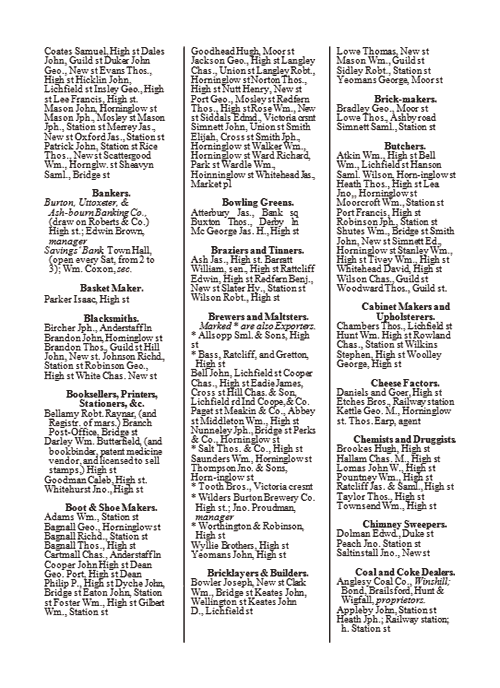
ACADAMIES (Marked ** take Boarders).
British, Guild Street., Jas. Samble and Anne Standley
Cleaver Mary, Horninglow Street
Cooke Jane, Horninglow Street
Dunwell William, High Street **
Dyche Mary Ann, Bridge Street
Free Grammar, Friar’s walk, Rev. Henry Day, head master; and Henry Hodson, second master
Graggs Mary & Jane, Horninglow Street
King Matilda, Station Street
Leedham Mary Jane, Horninglow Street **
National, (Christ Church,) Church Street, John Chappell & Ann Ford; Harriet Cox, infant mistress
Trinity, Horninglow Street., Henry Taylor & Sarah Ann Gould.
Infant’s, Anderstaff Lane, Mary Hoose
Union, Horninglow Street., William Freeman & Emma Oakden
Wragg Jemima, Market Place
ATTORNIES
Bass Abraham, Bridge Street
Coxon William, (& clerk to the Union,) Horninglow Street
Drewry James, High Street
Goodyer Henry, Guild Street
Perks John, Lichfield Street
Richardson & Small, High Street
Thornewill John, (and clerk to County Court, and to Magistrates,) Station Street, Green street
AUCTIONEERS
Leedham Fras., Nelson terrace
Wilkins Stephen, High Street
Bakers & Flour Dealers.
Burton William, Park Street
Coates Samuel, High Street
Dales John, Guild Street
Duker John George. New Street
Evans Thomas, High Street
Hicklin John, Lichfield Street
Insley George, High Street
Lee Francis, High Street
Mason John, Horninglow Street
Mason Joseph, Mosley Street
Mason Joseph, Station Street
Merrey Jas., New Street
Oxford Jas., Station Street
Patrick John, Station Street
Rice Thomas, New Street
Scattergood William, Horninglow Street
Sheavyn Samuel, Bridge Street
BANKERS
Burton, Uttoxeter, & Ashbourn Banking Co., (draw on Roberts & Co.) High Street.; Edwin Brown, manager
Savings’ Bank, Town Hall, (open every Sat, from 2 to 3); William Coxon, sec.
BASKET MAKER
Parker Isaac, High Street
BLACKSMITHS
Bircher Joseph, Anderstaff Lane
Brandon John, Horninglow Street
Brandon Thomas, Guild Street
Hill John, New Street
Johnson Richard, Station Street
Robinson George, High Street
White Charles, New Street
BOOKMAKERS, PRINTERS & CO.
Bellamy Robt. Raynar, (and Registr. of mars.) Branch Post-Office, Bridge Street
Darley William Butterfield, (and bookbinder, patent medicine vendor, and licensed to sell stamps,) High Street
Goodman Caleb, High Street
Whitehurst Jno., High Street
BOOT AND SHOE MAKERS
Adams William, Station Street
Bagnall George, Horninglow Street
Bagnall Richard, Station Street
Bagnall Thomas, High Street
Cartmall Charles, Anderstaff Lane
Cooper John, High Street
Dean George Port, High Street
Dean Philip, High Street
Dyche John, Bridge Street
Eaton John, Station Street
Foster William, High Street
Gilbert William, Station Street
Goodhead Hugh, Moor Street
Jackson George, High Street
Langley Charles, Union Street
Langley Robert, Horninglow Street
Norton Thomas, High Street
Nutt Henry, New Street
Port George, Mosley Street
Redfern Thomas, High Street
Rose William, New Street
Siddals Edmond, Victoria Cresent
Simnett John, Union Street
Smith Elijah, Cross Street
Smith Joseph, Horninglow Street
Walker William, Horninglow Street
Ward Richard, Park Street
Wardle William, Horninglow Street
Whitehead Jas., Market Place
BOWLING GREENS
Atterbury Jas., Bank Square
Buxton Thomas, Derby Lane
Mc George Jas. H., High Street
BRAZIERS AND TINNERS
Ash Jas., High Street
Barratt William, sen., High Street
Rattcliff Edwin, High Street
Redfern Benj., New Street
Slater Henry, Station Street
Wilson Robert, High Street
BREWERS AND MALTSTERS (Marked ** are also Exporters).
Allsopp Samuel & Sons, High Street **
Bass, Ratcliff, and Gretton, High Street **
Bell John, Lichfield Street
Cooper Charles, High Street
Eadie James, Cross Street
Hill Charles & Son, Lichfield Road
Ind Coope,& Co. Paget Street
Meakin & Co., Abbey Street
Middleton William, High Street
Nunneley Joseph, Bridge Street
Perks & Co., Horninglow Street
Salt Thomas & Co., High Street **
Saunders William, Horninglow Street
Thompson Jno. & Sons, Horninglow Street
Tooth Bros., Victoria Cresent **
Wilders Burton Brewery Co., High Street **
Worthington & Robinson, High Street **
Wyllie Brothers, High Street
Yeomans John, High Street
BRICKLAYERS AND BUILDERS
Bowler Joseph, New Street
Clark William, Bridge Street
Keates John, Wellington Street
Keates John D., Lichfield Street
Lowe Thomas, New Street
Mason William, Guild Street
Sidley Robt., Station Street
Yeomans George, Moor Street
BRICKMAKERS
Bradley George, Moor Street
Lowe Thomas, Ashby Road
Simnett Samuel, Station Street
BUTCHERS
Atkin William, High Street
Bell William, Lichfield Street
Hanson Samuel Wilson, Horninglow Street
Heath Thomas, High Street
Lea Jno, Horninglow Street
Moorcroft William, Station Street
Port Francis, High Street
Robinson Joseph, Station Street
Shutes William, Bridge Street
Smith John, New Street
Simnett Ed., Horninglow Street
Stanley William, High Street
Tivey William, High Street
Whitehead David, High Street
Wilson Charles, Guild Street
Woodward Thomas, Guild Street
CABINET MAKERS AND UPHOLSTERERS
Chambers Thomas, Lichfield Street
Hunt William High Street
Rowland Charles, Station Street
Wilkins Stephen, High Street
Woolley George, High Street
CHEESE FACTORS
Daniels and Goer, High Street
Etches Bros., Railway station
Kettle George M., Horninglow Street. Thomas Earp, agent
CHEMISTS AND DRUGGISTS
Brookes Hugh, High Street
Hallam Charles M., High Street
Lomas John W., High Street
Pountney William, High Street
Ratcliff Jas. & Samuel, High Street
Taylor Thomas, High Street
Townsend William, High Street
CHIMNEY SWEEPERS
Dolman Edward, Duke Street
Peach Jno., Station Street
Saltinstall Jno., New Street
COAL AND COKE MERCHANTS
Anglesy Coal Co., Winshill; Bond, Brailsford, Hunt & Wigfall, proprietors.
Appleby John, Station Street
Heath Joseph, Railway Station, Station Street
Jenkins Lambert, Railway Station, High Street
Walker William, Railway Station, Station Street
CONFECTIONERS
Bickley John, High Street
Coates Samuel, High Street
Lee Francis, High Street
Oxford James, Station Street
Scattergood William, Horninglow Street
Whittingham John, High Street
Wright William, High Street
COOPERS
Dearle Edward, Union Street
Ewers John, High Street
Jelly William, Cross Street
Johnson Chpr., Horninglow Street
Morris John, (and vat maker), Horninglow Street
Southerns Thomas, High Street
CORK CUTTERS
Cashman Michael, (and sock manufacturer) wholesale and retail, Horninglow Street
Wilders Henry, Market Place, Victoria crescent
CORN MERCHANTS
Bailey William, High Street
Douglas James, (and flour) Station Street
CORN MILLERS
Buxton John, Derby Lane
Wilson Joseph & Co., Burton Mill
CURRIERS AND LEATHER CUTTERS
Elliott Robert Spencer, (and Tanner), High Street
Marshall William, High Street
Pountney Thomas, Bridge Street
ENGINEERS AND MILLWRIGHTS
Capes & Burton, (and portable and steam engine manufacturers, Britannia Foundry, Horninglow Street
FARMERS
Greaves Elizabeth, Horninglow Road
Lathbury John, Whetmore House
Ordish James, Park Street
Parker Rd., (cowkeeper) George Street
Port John, Lichfield Road
Shutes William, Bridge Street
Wood William, Lichfield Road
FIRE AND LIFE OFFICES
Birmingham District, (Fire) William Nichols, Guild Street
County, (Fire) William Coxon, Horninglow Street
European, (Life) John W. Lomas, High Street
Industral & General, (Life) William Pountney, High Street
Mutual, (Life) C. Goodman, High Street
National Economic Hail Storm, John Riley, High Street
Norwich Union, William Scott Goodger, Bridge Street
People’s Provident, John Riley, High Street
Provident (Life) William Coxon, Horninglow Street
Royal Exchange, Henry W. Hodson, High Street
Scottish Amicable (Life) W. Dunwell, High Street
Star, Thomas Lowe, New Street
Traveller & Marines, John Riley, High Street
Times, Robert Thomas Smith, Cross Street
Unity, (Fire) John Riley, High Street
Yorkshire, John Whitehurst, High Street
FISHMONGERS
Appleby William, High Street
Wilson John, High Street
GARDENERS AND SEEDSMEN
Appleby William, Station Street
Heath Richard, High Street
Staley Thomas, New Street
Wardle William, Station Street
GLASS AND CHINA DEALERS
Abbott Richard, Bridge Street
Wildman Sarah, High Street
GREENGROCERS
Appleby Henry, Lichfield Street
Bagnall Richard, Guild Street
Bladon Mary, High Street
Brown Oliver, Park Street
Redfern Thomas, High Street
Young Robert, High Street
GROCERS AND TEA DEALERS
Adams John & Son, High Street
Bickley John, High Street
Birch Henry High Street
Brookes James, (wholesale & retail), New Street
Burton John, Guild Street
Buxton Joseph, Moor Street and Station Street
Buxton William, Park Street
Dales John, Guild Street
Dams Allen, Horninglow Street
Dickinson John, High Street
Dukes John George, New Street
Evans Thomas, High Street
Gane Elizabeth, New Street
Goodhead Samuel, Horninglow Street
Goodger William & Son, Bridge Street
Haddon Martha & Son, (John), Moor st and Horninglow Street
Hickling John, Lichfield Street
Hudson William, Horninglow Street
Killeen Charles, New Street
Lathbury Richard, High Street
Leedam William Whittingham, High Street
Mason John, Horninglow Street
Mason Joseph, Moseley Street
Mason Joseph, Station Street
Ratcliff Jas. & Samuel, High Street
Sanders Charles, New Street
Scattergood William, Horninglow Street
Streeter Harriet, Lichfield Street
Wayte Ann M., High Street and Lichfield Street
Whittingham John, High Street
Worsey Thomas, High Street
Wright William, High Street
HAIR DRESSERS
Bradley William, New Street
Foster Henry, Horninglow Street
Goodwin John, High Street
Hanson Thomas, High Street
Lakin Charles, Horninglow Street
Martin John, Station Street
Port Horatio, Lichfield Street
HATTERS
Hawkins John, Bridge Street
Kelsey John, High Street
HOOP (Wood) MAKERS
Riley Charles, Victoria Crescent
Riley William, Moor Street
Tunnadine Henry, Horninglow Street
HORSE AND GIG AND CAB PROPRIETORS
Eardley Ellen, Bridge Street
Teat Samuel, Horninglow Street
HOSIERS
Cooper John, High Street
Fitchett Benjamin, Horninglow Street
Herratt Samuel, (and toy dealer) High Street
Jackson George, High Street
Mansfield Ann, Horninglow Street
Roe Thomas, High Street
INNS AND TAVERNS
Anchor, Joseph Bowler, New Street
Angel Commercial Inn, Jas.
Atterbury, Bank square
Barley Mow, William Wood, Park Street
Bear Inn, Thomas Frederick Dugmore, Horninglow Street
Bell, Joseph Phillips, Horninglow Street
Black Horse, John Oakden, Moor Street
Blue Posts, Mary Yeomans, High Street
Boot, Fras. Whitby, High Street
Bowling Green Inn, Thomas Buxton, Derby Lane
Carpenters’ Arms, William Gretton, New Street
Coach & Horses, John Redfern, High Street
Devonshire Arms, William Appleby, Station Street
Dog, Jno. Carder, Lichfield Street
Dingo, Joseph Bircher, Victoria Crescent
Fox & Goose, Ellen Eardley, Bridge Street
George Inn, Henry Townsend, High Street
Guild Tavern, Ann Greves, Guild Street
King of Prussia, William Gibson, New Street
Lamb, William Milward, High Street
Leopard, William Swindale, Abbey Street
Midland Coml. Hotel, Michael Atkins, Station Street
Nag’s Head, John Ducker Keats, Lichfield Street
Old White Lion, Frederick Dickinson, Lichfield Street
Plough, Thomas Soar, Horninglow Street
Queen’s Commercial & Posting Hotel, John Witton Lees, Bridge Street
Rising Sun, Robert Smith, Horninglow Street
Royal Oak. John Hooper, Market Place
Sarcen’s Head, William Hoult, Bridge Street
Spirit Vaults, William Chambers, Bridge Street
Spread Eagle, Joseph Baker, New Street
Spread Eagle, Joseph Hill, Lichfield Street
Star, Sarah Meason, High Street
Swan, Thomas Johnson, Anderstaff Lane
Talbot, Martha Blood, Horninglow Street
Union Inn, James Gaunt, Horninglow Street
Wheat Sheaf, Edward Morrall. High Street
White Hart, commercial and posting Hotel, James Henderson Mc George, High Street
White Horse, Frances Woolley, High Street
White Lion, John Downing, High Street
BEERHOUSES
Annable Benj., Horninglow Street
Allard Samuel, Green Street
Appleby John, Station Street
Atkin Edward, New Street
Atkin Abraham, Victoria Cresent
Barnes Abraham, Cross Street
Beddows Thomas, New Street
Bircher William, Anderstaff Lane
Bond William, Station Street
Blant Joseph, New Street
Brailsford John, Guild Street
Cookes William, Union Street
Cooper Charles, High Street
Cross Thomas, Lichfield Street
Dyche Samuel, Horninglow Street
Elson George, Anderstaff Lane
Fern John, Lichfield Road
Finch George, Victoria Cresent
Fisher Peter, Duke Street
Goodhead James, Station Street
Harrison Joseph, High Street
Jeffcoat Enoch, Cross Street
Johnson Richard, Station Street
Johnson William, New Street
Marlow William, Guild Street
Orme Thomas, New Street
Orton Richard, Park Street
Robinson Fras., Lichfield Road
Sandars Samuel, Anderstaff Lane
Smith Henry, Moor Street
Southern William, Lichfield Street
Strettan Thomas, Anderstaff Lane
Stringer Elizabeth, Horninglow Street
Thacker John, Horninglow Street
Turner David, Victoria Cresent
Turner Edwin, Anderstaff Lane
Ward John, Abbey Street
Watson George, Mosley Street
Winfield Williams, High Street
Yeomans Thomas, Lichfield Street
IRONFOUNDERS AND ENGINEERS
Halbard Philip, (and stove grate manufacturer), Horninglow Street
Thornewill & Warham, New Street
Wright, Salisbury & Co., (and stove grate manufacturers) ,Anderstaff Lane
IRONMONGERS
Ash James, High Street
Barratt William, senior, (and letter cutter, stove grate, kitchen range, and cooking apparatus manufacturer), High Street
Bindley Thomas, High Street
Ratcliff Edward, High Street
Smith George, High Street
Wilson Robert, High Street
JOINERS AND BUILDERS
Bagnall Thomas, Mosley Street
Corder John, Lichfield Street
Deville Samuel, George Street
Dickinson Daniel, (and boatbuilder), Lichfield Street
Heath Richard, High Street
Hunter & Bennett, Duke Street
Mason Henry, Station Street
Sherwin Joseph, Union Street
Stratton John, Lichfield Street
LIBRARIES
Darley William B., (circulating), High Street
Permanent Library, Bridge Street, Robert Bellamy, librarian
Young Men’s Christian Association, Guild Street.; Joseph G. Wright, librarian
LINEN AND WOOLEN DRAPERS
Douglas George, High Street
Hawkins, Son, and Nephew, Horninglow Street
Jones William. High Street
Kelsey John, High Street
Ordish Walter Daniel, High Street
Robinson John, High Street
Sowter Thomas, Station Street
Styan John Chpr., High Street
Walker William, High Street
MILLINERS
Bladon Mary, High Street
Bryan Mary, High Street
Carter Elizabeth, Station Street
Evans & Ordish, High Street
Ewers Eliza, New Street
Fitzsimons John, High Street
Gaunt Diana, Horninglow Street
Glover Elizabeth, Market Place
Heginbotham Elizabeth, Lichfield Street
Jefford Ann, Horninglow Street
Jones Rebecca, High Street
Milner Lucy & Elizabeth, High Street
Morris Amelia, Station Street
Redfern Jane, High Street
Robinson Mary, (and silk mercer), High Street
Rose, High Street
Southerns Ann and Sarah, Horninglow Street
Wheatcroft Ann, High Street
Willsher Sarah Ann, Orchard Street
NAIL AND RIVET MAKERS
Jackson George Frederick, New Street
Renwick Thomas, New Street
Stringer Elizabeth, Horninglow Street
Whiteman, Brett, and Bartle, Horninglow Street
NEWSPAPERS
Burton Times, published every Saturday, by John Whitehurst, High Street
Burton Weekly News, published by Robt. R. Bellamy, every Friday, High Street
PAINTERS & CO.
Green John, High Street
Harrard Math., Anderstaff Lane
Newbold George, Lichfield Street
Rastall Joseph, Horninglow Street
Stanley William, High Street
PLASTERERS
Simpson John, New Street
Simpson, John, jun., Moor Street
PLUMBERS AND GLAZIERS
Fitchett William, High Street
Fletcher Samuel, Lichfield Street
Knight Frederick, New Street
Nichols William, (& gas fitter & coppersmith) Guild Street
Sandars Samuel, Station Street
Turner James, Guild Street
PROFESSORS OF MUSIC
Barratt George Paul, (and organist and teacher of the
pianoforte, thorough bass, harmony, and composition), Station Street
Day Lewis, Lichfield Road
Orme George, High Street
REFRESHMENT ROOMS
Doherty Laura, Maria, (and dealer in British wines), Station Street
Whittingham John, High Street
REGISTER OFFICES FOR SERVANTS
Doherty L. M., Station Street
Jackson George, High Street
Simnett William Henry, Guild Street
ROPE AND TWINE MAKERS
Elson James, High Street
Lowe John, Fleet Street
SADDLERS AND HARNESS MAKERS
Brooke William, High Street
Gibson Thomas, High Street
Newbold Thomas, High Street
Orme Thornas, New Street
Ward William, High Street
SHOPKEEPERS
Bannister S., Horninglow Street
Collier William, Cross Street
Cox Thomas, Moor Street
Dales Robert, Station Street
Dickinson Daniel, Lichfield Street
Elson George, Anderstaff Lane
Elson Thomas, Anderstaff Lane
Harris Jas. Kellem, Station Street
Heath William, High Street
Hurst George, New Street
Patrick John, Station Street
Merry James, New Street
Newell Henry Thomas, New Street
Renwick Thomas, New Street
Slater William, Moor Street
Talbot Jane, Park Street
Underwood Thomas, High Street
Walker William, Horninglow Street
Waterson Thomas, Anderstaff Lane
Woolley Wm, Horninglow Street
Yeomans Handel, Victoria Crescent
STONE MASONS (Marked * are Merchants).
Bassett David, Station Street
* Clark Thomas & Son, Green Street
* Clark William, Bridge Street
Harrison Joseph, High Street
Parker James, Horninglow Street
STRAW HAT MAKERS
Egginton Mary, Bridge Street
Gaunt Diana, Horninglow Street
Jones Rebecca, High Street
Jefford Ann, Horninglow Street
SURGEONS
Belcher Robert Shirley, Lichfield Street
Hawkeswotth Charles A., High Street
Leedam William A., High Street
Lowe George, Horninglow Street
Mason William, Horninglow Street
SURVEYORS AND LAND AGENTS
Grace Robert, Station Street
Spooner Thomas, Union Street
Whitehead Henry Egginton, Lichfield Street
TAILORS AND DRAPERS
Brunt and Ward, High Street
Dakin John, Horninglow Street
Dakin Joseph, Guild Street
Denston Moses, jun., Cross Street
Feakes William, Horninglow Street
Goodhead William, Union Street
Gothard William James, High Street
Jackson George, High Street
Leedam Charles, High Street
Mousley William, Lichfield Street
Marklew Edward & Son, High Street
Orgill Matthew, High Street
Orgill Thomas, High Street
Parry Richard, Victoria Crescent
Smith Thomas, Bridge Street
Webb John, High Street
Weston Charles, High Street
TIMBER AND SLATE MERCHANTS
Clark Thomas & Son, Green Street
Perks Charles & Sons, Lichfield Road
Riley William, Moor Street
TOBACCONISTS
Doherty Laura Maria, (and dealer in foreign & British
cigars, Meerschaum and other pipes), Station Street
Moger Joseph, Market Place
TURNERS AND CHAIR MAKERS
Gilbert William, Guild Street
Moore Charles, Guild Street
Noon William, Anderstaff Lane
Simpson Thomas, Guild Street
Simpson William, High Street
Summers Charles, New Street
West Thomas, Bridge Street
UMBRELLA MAKERS
Martin John, Station Street
Tong John, High Street
VETERINARY SURGEONS
Taylor Thomas, High Street
Wildsmith George, Market Place
WATCH AND CLOCK MAKERS
Sherwin Joseph, High Street
Steer John, High Street
Sutton John, Lichfield Street
Wilson Thomas, High Street
Worthington Thomas, High Street
WHEELWRIGHTS
Bailey Edward, Horninglow Street, Duke Street
Port Philip, Hawkins Lane
Sandars Samuel, Anderstaff Lane
WHITESMITHS AND BELLHANGERS
Barratt William, sen., (and locksmith), High Street
Mansfield Samuel, (and machinist) Horninglow Street
Webster George, High Street
WINE AND SPIRIT MERCHANTS (Marked * are also retaillers)
Lyon, Joule, and Parsons, Bridge Street
* Mc George, Jas. H., High Street
Morrall Edward, (ale and porter merchant), High Street
* Smith Edmund., Market Place
* Smith William, Horninglow Street
Worthington William & Son, (importers) High Street Railway Conveyance.
BURTON UPON TRENT TRANSPORT
Midland Railway Co.’s Station, Foot of Station Street.
Trains several times a day, to all parts; Rd. Dilworth, station master
Omnibus from the Queen’s Hotel meets every train
Carriers by Railway.
Midland Railway Co., (to all parts); Pickford and Co., agents
Water Conveyance.
Grand Junction Canal Co., (carriers by fly boats to all parts), Bond End; William Shardlow, agent
Carriers from the Inns.
Those marked 1 go from the Angel; 2, Bear; 3, Blue Posts; 3½, Coach & Horses;
4, Star; 5, White Horse; and 6, White Lion.
3 Alrewas, Harrison, Thurs.
4 Appleby, J. Fish, Thurs.
1 Ashby-de-la-Zouch, Thomas Broadhurst, Thurs.
6 Austery, Orton, Thurs.
2 Barton – under – Needwood, Geary, Tu., Thur. & Sat.
3½ Barton-under-Needwood, Bakewell, Thur. & Sat.
2 Birmingham, Boswell, Tues.
1 Church Broughton, Joseph Jackson, Thurs.
3 Church Broughton, William Cooke, Thurs.
1 Coton, Whetton, Thurs.
3 Coton, William Lester; Thurs.
Derby, James Salt, from New Street, Mon., Wed. & Fri.
5 Egginton, Baldwin, Thurs.
4 Gresley, Gilbert, Thurs.
1 Hanbury, Jas. Burnan, Thurs.
5 Hartshorn, Glover, Thurs.
6 Hartshorn, Cooke, Thurs.
1 Hatton, George, Locker, Thurs.
5 Hilton, Yeomans, Thurs.
1 Marchington, Parker, Thurs.
3 Newall, Thomas Taylor, Thurs.
1 Netherseal, John Mear, Thurs.
3½ Newborough, Easom, Thurs.
1 Overseal, Redfern, Thurs.
4 Overseal, Stewardson, Thurs.
1 Repton, Marshall, Thurs.
4 Repton, Maddocks, Mon. and Thurs.
3 Ticknall, Jas. Peace, Thurs.
2 Tutbury, Mayer, Mon. and Thurs.
1 Walton, Redfern, Thurs.
3 Yoxall William Mosedale, Thurs.
3½ Yoxall, John Upton, Thurs.
WINSHILL TOWNSHIP
Anglesey Coal Company, Ashby Road, Bond, Brailsford, Hunt., and Wigfall, proprietors.
Bailey Misses, boarding school, Bladen hill
Cooper Thomas, brickmaker
Croxall Ann, schoolmistress
Douglas James, flour factor, Alma House
Emery Henry, vict., Royal Oak
Finlay John, Esq., Trent Cottage
Fletcher David, shoemaker
Forman Robert, coal master, Bridge end
Hunt Sarah, shopkeeper
Lowe Thomas, brickmaker
Measham George, beerhouse
Morris Samuel, pipe maker, Bridge end
Plummer John, vict., Jolly Farmer
Sharratt Thomas, beerhouse
Shephard Joseph, brick maker
Siddalls John, brick maker
Taverner John, tape manfactr., Forge mills
Tomlinson Robert S., surgeon, Wood field
Toone Thomas, pipe maker
Wardle Frank, Esq., High Field
Wilson Joseph and Co., corn millers, Burton mill
Woodhead Mr. George, Bridge end
WINSHILL FARMERS
Fitchett Joseph & Richard
Hallam Charles
Hallam Francis
Henson Thomas
Hardy Richard
Newton William
Sale William
Taylor Thomas

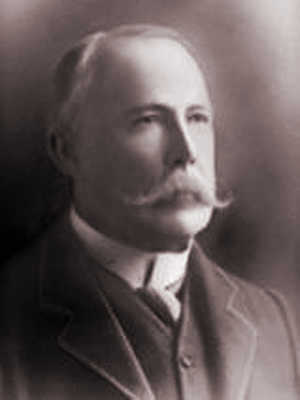 Thomas Thornewill (senior) was baptised in Burton Parish Church on 4th October 1719, the son of Thomas and Elizabeth Thornewill.
Thomas Thornewill (senior) was baptised in Burton Parish Church on 4th October 1719, the son of Thomas and Elizabeth Thornewill.
The Thornewill firm dates back to at least 1732 making iron goods. Thomas Thornewill (junior) was apprenticed in that year, at the age of thirteen.
Thomas Thornewill (senior) married Elizabeth Astle on 20th October 1746. She was the widow of Francis Astle, a noted local feltmaker and hatter who had died in 1735. He had left most of his properties to his wife Elizabeth (by a will of 20th May 1735), including a freehold house, on the south side of New Street. She was to have the use of this house for the remainder of her life, and it was then to be sold by Astle’s executors, Thomas Towndrow (gentleman) and John Downes (feltmaker), and the proceeds invested in land worth £5 a year to provide clothing for four poor boys of Richard Allsop’s Charity School in Burton.
Thomas Thornewill of Burton, now listed as ‘Edge Tool maker’ settled the property and its contents to Elizabeth, so that if he died they would pass to her. In 1751, Thomas leased a garden adjoining his freehold property on its eastern side, from William Jordon (cooper) for an annual rent of six shillings. This is significant in that it was the first move towards an expansion of the Thornewill property between New Street and Park Street (which was then known as Pinfold Lane).
Elizabeth, Thomas Thornewill’s wife, died in 1755 and it became the duty of Francis Astle’s executors to dispose of the freehold property in accordance with his will. The freehold property was advertised for sale in the “Derby Mercury”. Thomas Thornewill of Burton and his brother Francis of Clay Mills, both now listed as ‘Edge Tool Makers’ purchased the freehold property in New Street from Thomas Towndrow, the surviving executor or trustee of Francis Astle, for the sum of £140.
By 1760 the Thornewill brothers had established a small business there still making edge tools such as axes, knives and spades. From this time on they began to systematically expand their property in New Street whenever the chance arose. It was not however, their only business interest. A reference to Clay Mills in a 1760 indenture shows that the Thornewills were already in possession of the Forge Mill there. This was sited on the Mill Fleam, a watercourse branching from the River Dove, on or near the site of an old water corn mill. The exact dates when the Thornewills leased the mill and opened the forge are not known, but were probably around the year 1740.
Water power was needed for working the bellows and hammers in the forge and also to operate rolling and slitting mill. The forge usually consisted of a “finery” in which the iron was hammered into blooms and a “chafery” in which the blooms were reheated and beaten into bars. In the rolling and slitting mills the iron was rolled into sheets and then cut into rods ready for the nailers. The Thornewill’s forge may not have had rolling and slitting mills attached in 1760, but it certainly had in 1807 when they purchased the premises outright.
In 1760 about 25,000 tons of iron were imported annually into England (approximately 50% of the requirements) mainly from Russia and Sweden. The Thornewills used this imported iron, which they purchased from the Burton brewers of the time, such as Benjamin Wilson, John Walker Wilson and Samuel Sketchley. The brewers normally accepted some iron, flan or timber as part payment for the beer that they exported along the Trent to the Baltic countries.
Thomas Thornewill (ironmonger and spademaker) leased the White Hart Inn in High Street from the Earl of Uxbridge on 23rd September 1769. Later in the year, he sub-let a house and garden on the north side of New Street (which he previously leased from the Earl of Uxbridge) to John Shorthose (turner). In a property lease of 1770 John Shorthose is described as a spademaker and was an employee at the Thornewill works in New Street.
In March 1772, Thomas and Francis Thornewill leased from the Earl of Uxbridge, two further tenements and a garden to the east of their freehold property, and also a property to the west. Ever expanding, Thomas also leased land at Stretton, including some waste land near the forge.
By 1778 the Thornewill’s business had grown considerably. They were in possession of extensive properties in Burton, particularly in New Street, and at Clay Mills, Stretton. They were purchasing large quantities of imported iron, (for example, in August, 1778 Thomas Thornewill bought 658 iron bars imported by John Walker Wilson from St. Petersburg, Russia, for £273 7 6) and were manufacturing considerable quantities of spades, iron hoops, iron plate and other forms of hardware. They were probably the main suppliers of iron hoops to the Burton brewers of the time, and this was no doubt the way in which the firm developed as brewery engineers.
At the beginning of 1784, Thomas Thornewill made his will, and in this he left his leasehold properties to his daughter Sarah Spiers. After Thomas’s death Sarah sold the property lying to the east of the freehold property, to George Wood for £125, and it was not until 1834 that the Thornewills were able to buy it back from George’s son William. The Wood family, together with William Shorthose, Philip Port and William Smith were also, at this time, eager to acquire land on the south side of New Street, where they operated (approximately 1775 1835) a large screw making works. No doubt the Thornewills supplied this firm with iron.
Thomas Thornewill (senior) died in 1786 and the firm came under the management of Thomas, his son, and Francis, his brother.
In the same vein as his father, in 1801, Thomas Thornewill leased two more properties on the South side of New Street.
Francis Thornewill made his will in 1805 which showed that he was a man of considerable wealth. He left the bulk of his estate to his sons, John and Francis, but he was still able to leave £500 to his daughter Anne; and £200 to his grand daughter Anne Neal. He died just 2 years later in 1807 having done much to build up the business. He had also been one of the Townmasters in 1792 and was a Feoffee in 1794.
In March 1807, Thomas Thornewill (junior) purchased outright for £3,220, extensive properties and rights at Clay Mills from the Earl of Uxbridge. These included:
(a) “Cliffcroft” 7 acres of land containing Dove Cliff House, that was built for him about 1700, gardens, plantations, pleasure grounds, etc.
(b) Clay Mill forge with “all those iron works and all the slitting mills, forges, warehouses, buildings and works belonging thereto”.
(c) A warehouse and tenement near the Grand Trunk Canal in Stretton.
The Grand Trunk Canal had been opened in 1770 and was a considerable improvement on the Trent navigation.
By 1811, Thornewill’s were operating a forge at Wichnor as well as at Clay Mills. At the latter there was also a foundry and an iron casting house.
In the 1818 edition of the Bradshaw & Parsons Directory of Staffordshire, there are two Thornewill listings, the new one being in New Street. These appeared as:
Although not listed in the Directory, Thornewill & Co. also held the forge at Stretton (Clay Mills) and William Gretton was the iron master there. At the time, there were also recorded living in the area around the works an iron founder, a foundry man, three spade makers, end three nailers, in addition to six patten ring makers and fourteen screw forgers who worked at the nearby screw mill.
By 1834, the Bradshaw & Parsons Directory had pretty much been replaced by The White’s Directory of Staffordshire. The listed had changed slightly to:
In 1835/36 the leases for the New Street properties were successfully renewed. By 1837, most of these premises together with the freehold property were in the possession of Robert, John and Francis who were now running the business.
By 1837, Thomas Thornewill made his will. By this time, he was 77 years of age and had taken little part in the running of the business for some time. A few of the main clauses of his will illustrate the considerable wealth that the Thornewill family had acquired since 1760 when Thomas (senior) and Francis (senior) had raised the £140 to buy the freehold premises in New Street. It listed:
During 1839, the New Street premises were further extended and the firm constructed a number of new buildings on its existing land. A large area of land extending to Pinfold Lane was also purchased by Robert Thornewill from Thomas Lambert and in 1840, the date above a new archway marked the alterations.
A large two storied building was built in 1845. Mr. William Jones, the tenant of the neighbouring property, wrote a letter to Robert Thornewill complaining about the number of windows in the upper storey of the new building.
On 1st Feb 1847, Robert Thornewill purchased the leasehold premises, to the west of the freehold property, from Thomas Cooper. These very old premises had, for the previous one hundred and fifty years been used by Francis Astle, Thomas Cooper and others, as a hat factory. At a later date the houses were demolished or extensively modified to form the present offices.
An Indenture of partnership between Robert Thornewill and J.R. Warham (engineer), now described as engineers, ironfounders and iron merchants was signed on 2nd July 1849
Robert Thornewill purchased a piece of land adjoining the west side of the works in Park Street from William Wood in 1852. This meant that the site now occupied a complete 2 acre plot of land between New Street and Park Street.
It was probably about this time also that the business changed considerably in the types of goods that it produced. From its beginning to about 1845 it was little more than a hardware firm making iron, copper, and brass goods for use locally, particularly in the Burton breweries. From 1845 onwards it became an engineering firm in the true sense, and it is significant that Bagshaw, in his Directory of Derbyshire of 1846, lists the firm of Robert Thornewill of New Street iron and brass founders and steam engine makers. These early engines were probably sold mainly to local collieries and breweries.
The 1851 White Directory of Staffordshire, stated that Thornewill and Warham Iron foundry and Engine and Machine Works in New street “employs 75 men and 25 boys”. He also mentioned that Thornewill & Co. had an ironworks at Clay Mills, and that Edward Thornewill lived at Dovecliff House, Rolleston.
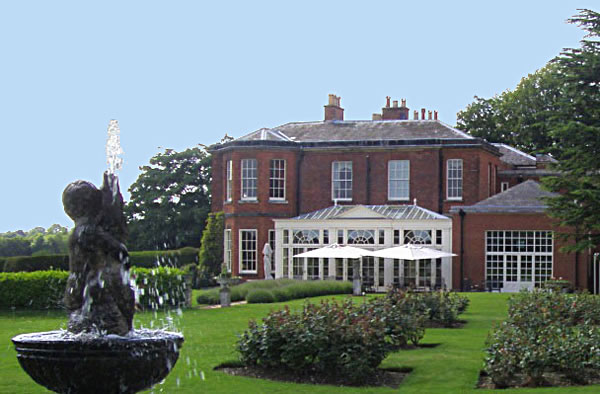 Dovecliff House, Rolleston
Dovecliff House, Rolleston
Robert Thornewill (senior) died in 1858 and his share of the business passed to his wife Martha Hammond Thornewill (neé Wright), in accordance with his Will of 20th Feb 1856.
An article in The Burton Weekly News of 30th March 1860 stated “apart from brewing, the only considerable manufactory now is Messrs Thornewill and Warham’s iron foundry and Engine and Machine Works.”
By this time the firm was producing approximately fifteen to twenty steam engines annually. These consisted of pumping, haulage and winding engines and tank locomotives which were sold mainly to collieries in Derbyshire, Leicestershire, Staffordshire and Warwickshire. A few were sold to Burton breweries and to ironworks and lead mining companies in the Midlands.
On 25th November 1868, the partnership of M. H. Thornewill and J. R. Warham was dissolved to allow Robert Thornewill pictured above (son of Robert Thornewill (senior) who had died in 1858) to enter. At this time the property, stock and other assets of the firm were valued at £43,048 1 6 of which M. H. Thornewill held £27,720 15 7 and John Robson Warham £15,327 5 11.
Under the new partnership agreement J. R. Warham was to control 6/12ths, M. H. Thornewill 5/12ths, and R. Thornewill 1/12th of a total capital of £44,000.
At the end of 1878, Thornewill and Warham purchased a piece of land with a number of properties, on the corner of Lichfield Street and Park Street, from Frederick Gretton, a brewer of Burton, for £2,500. It adjoined John Bell’s brewery on its north east side. In 1879 some of this land was sold to the Midland Railway Co., who built a line through Thornewill and Warham’s premises from the south side of Station Street to the Bond End Railway.
Two years later, in 1880, Thornewill and Warham purchased property on the south side of New Street, to the west of their own premises, from the Trustees of G. R. Bircher. This consisted of premises fronting New Street, originally an inn known as the Old Queen’s Head, and 423 sq. yds. of ground to the rear.
In approximately 1885 Thornewill and Warham exported three engines to Japan to be used for winding and hauling at Taskanna Colliery. After 1885 the number of engines made for export increased considerably the following extracts from the firm’s order book illustrates this:
Not only did Thornewill and Warham considerably expand the extent of their market, they also greatly extended the range of their manufactures. By 1880 they were producing a full range of brewery equipment, including various types of refrigerators, and indeed were capable of producing all types of machinery and metal goods.
On 26th March 1886, J.R. Warham died, leaving his share of the business to his wife, Anne Jane Warham of Birmingham, and to his son, William Warham (gentleman) of Seaham Harbour, Co. Durham. M.H. and Robert Thornewill purchased these shares and thus the business became an entirely family concern again after a break of 37 years.
In 1889, Thornewill and Warham made the contribution to Burton for which they are best known… having built the Andresey Bridge by special commission, they were commissioned by Michael Arthur Bass (later to become Lord Burton) to build the Ferry Bridge. The Ferry Bridge was opened on 3rd April 1889, and the viaduct linking it to Bond End added a little later at the total cost of just over £10,000. A few weeks later on 24th April 1889 Martha Hammond Thornewill died, and her share of the business passed equally to her three sons, Rev. Charles Francis, Robert and Arthur, in accordance with her will of 1st Feb 1889. Charles Francis sold his share in 1890 and Arthur his in 1893, leaving Robert in control of the business.
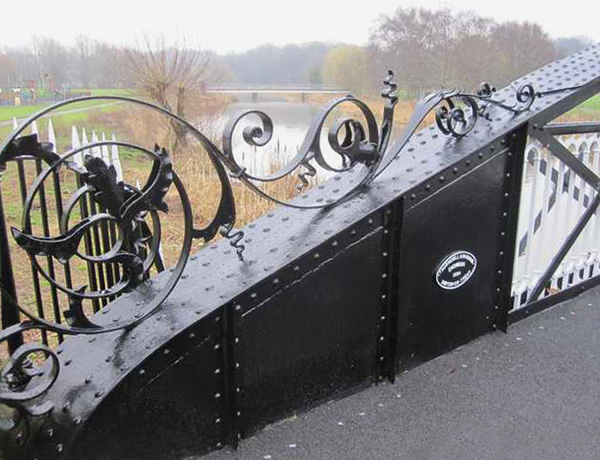 Andresey Bridge
Andresey Bridge
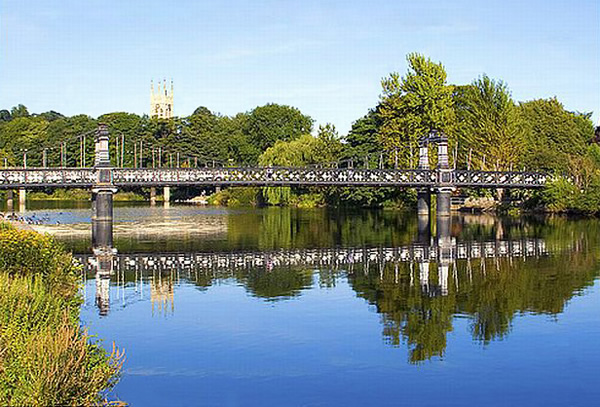 Ferry Bridge
Ferry Bridge
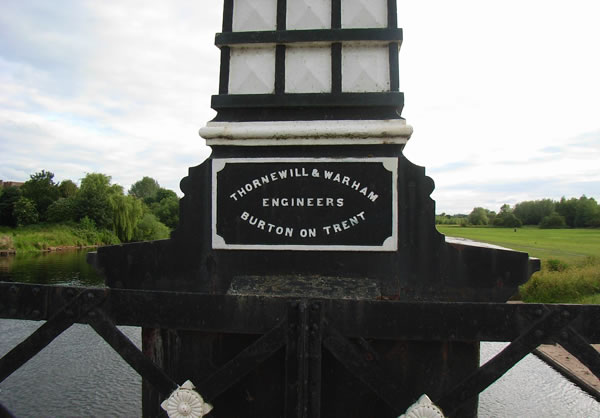
By 1895 Thornewill and Warham were manufacturing approximately twenty steam engines a year. Between 1870 and 1895 they made 500 (including locomotives). Of the 329 that can be traced in the engine order book they were installed in the following types of works:
In 1907, assignment of the business changed from Robert Thornewill Esq. to Thornewill and Warham Ltd. Robert Thornewill died in 1914, leaving two daughters, Ella Violet and Kathleen Hamilton
1919 marked the end of an era when Thornewill and Warham Ltd. went into liquidation and a new company of the same name was formed. This was purchased by S. Briggs & Co. Limited which remains successful today but was moved from the New Street premises to new premises in Derby Street to make way for the Octagon Shopping Centre.

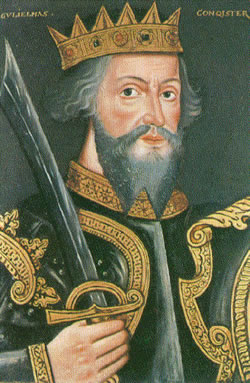 William the Conqueror (William I) is recorded to have come to Staffordshire in person during 1069 and 1070 in campaigns to stamp out rebellion. The force of this and general level of destruction was so great that large crowds of men, women and children wandered as far south as Evesham trying to scavenge food. William I is also known to have visited the shrine of Saint Modwen so certainly visited Burton and its Abbey.
William the Conqueror (William I) is recorded to have come to Staffordshire in person during 1069 and 1070 in campaigns to stamp out rebellion. The force of this and general level of destruction was so great that large crowds of men, women and children wandered as far south as Evesham trying to scavenge food. William I is also known to have visited the shrine of Saint Modwen so certainly visited Burton and its Abbey.
A survey later nicknamed and now commonly known as ‘The Domesday Book’ was compiled on the order of King William in 1086.
In the Burton entry in the ‘Domesday Book’, it is wrongly entered as ‘Stafford’ instead of ‘Burton’ which led to some later confusion. 20 estates were bestowed in Staffordshire by Wulfic but only 9 of these are recorded in the survey. Despite the Abbey, Burton was actually recorded as smaller than Stretton.
The Norman lords who accompanied William on the conquest of England were rewarded with land and title. The most significant beneficiary in the Burton area was Henry de Ferrers, who was given Tutbury castle in 1071. Another was Robert de Toeni whose son Nigel obtained Drakelow and Gresley. Royal commissioners visited each area and the inhabitants gave the information required in Old English although the final record was written in abbreviated Latin. Henry de Ferrers, of Tutbury castle, was one of the commissioners for Staffordshire.
William’s principal aim in making the survey was to provide a complete audit of England for the purposes of tax assessment. It was also used as a land registry to record new rightful ownership which could be used to settle disputes of ownership that had arisen in the twenty years since the battle of Hastings in 1066.
One unit of measure used in the ‘Domesday Book’ a ‘hide’. This was the amount of land that could be ploughed by a team of 8 oxen in a year and was equal to around 120 acres. A quarter of this was the ‘virgate’, and an eighth the ‘bovate’, which therefore, represented the amount of land that one ox could plough in a year and was around 15 acres.
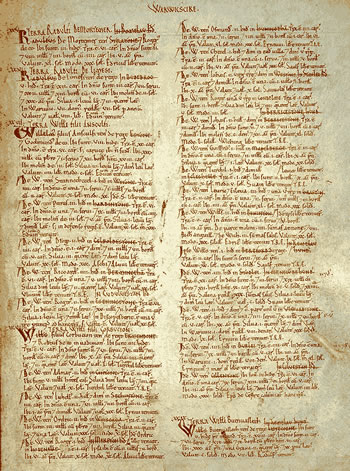 Aside from ‘The Domesday Book’ survey, two later surveys were made in 1114 and 1126 to record the Burton Abbey estates. These show record a class of persons known as ‘censarii’ or rent-payers. An example is William (of) Shobnall. He held two bovates of land for which William (of) Shobnall paid a rent of two shillings a year. Another example was Tintor, the dyer, who also paid a more expensive two shillings and sixpence for his two bovates and also had to adhere to an agreement to work his plough on the Abbey Demesne (home farm) twice a year and had to mow three times in August.
Aside from ‘The Domesday Book’ survey, two later surveys were made in 1114 and 1126 to record the Burton Abbey estates. These show record a class of persons known as ‘censarii’ or rent-payers. An example is William (of) Shobnall. He held two bovates of land for which William (of) Shobnall paid a rent of two shillings a year. Another example was Tintor, the dyer, who also paid a more expensive two shillings and sixpence for his two bovates and also had to adhere to an agreement to work his plough on the Abbey Demesne (home farm) twice a year and had to mow three times in August.
In 1121, Ralph the ox-herd of Winshill had charge of four oxen and had to plough the Abbey Demesne. In return for this, held 8 acres of land.
The later surveys suggest that as many as two thirds of the inhabitants of Burton were omitted from the Domesday survey, most likely due to deliberate evasion to avoid taxes.
Another listed class of person was a ‘villein’. They were a class of medieval land tenants who held the legal status of freemen in their dealings with all people except their lord. A medieval village or manor usually contained several classes of laborers, consisting of in order of hierachy, the villein, the serf and peasant.
There might be a number of freemen, who paid a fixed rent, either in money or produce, for the use of their land. Gradually the distinction between the villein and the serf disappeared. Most of the peasants were serfs or villeins. The serf and the villein laboured in the lord’s household or at work on his domain. Under feudalism the lords and nobles of the land had certain rights over Medieval Villeins which included the right of jurisdiction, which gave judicial power to the nobles and lords and the right of hunting.
Among the local villeins listed in the early 12th century surveys was Alwin. He owed two day’s work on the Abbey Demesne every week. He also had to fetch salt once a year and fish on some occasions. At Christmas he had to bring a cartload of wood to the abbey and provide two hens, and during the year he had to make a ‘sester’ (large measure of malt) used by the monks for brewing, and fulfil various other obligations to pay for the right to graze his pigs.
Other recorded groups of tenants on the Abbey lands were cottagers, working one day a week on the Demesne for their small plot of land, and oxen (usually one or two). In addition the surveys mention a number of skilled craftsman such as goldsmiths, dyers and masons, each of whom paid between sixpence and eighteen pence for a dwelling house with around half an acre of attached land.
The two surveys suggest that in the early 12th century the arable Demesne land, which was scattered about the open fields in pieces called ‘flatts’ totalled about 500 acres within the manor of Burton. On the manor, the Abbey also had four oxen for drawing lime and four for drawing timber, one horse for harrowing, 70 mares and foals in the breeding stud, three Spanish asses, nineteen cows, one bull, eight heifers, two oxen not used for draught and 128 pigs.
The total Burton population is estimated at about 60 households. The ‘Domesday Book’ mentions just nine villeins.
The area of the Burton Demesne was limited by the fact that Burton was a town and Demesnes elsewhere on the Abbey estates, for example in Shobnall, were larger. Crops grown included wheat, barley, oats, rye, peas, beans and vetch. The Abbey was largely self-sufficent in food, the fertile soils of the river plain providing for both arable cultivation and cattle-rearing; the river provided fish and power for the water-mills, also listed, to grind the corn.
